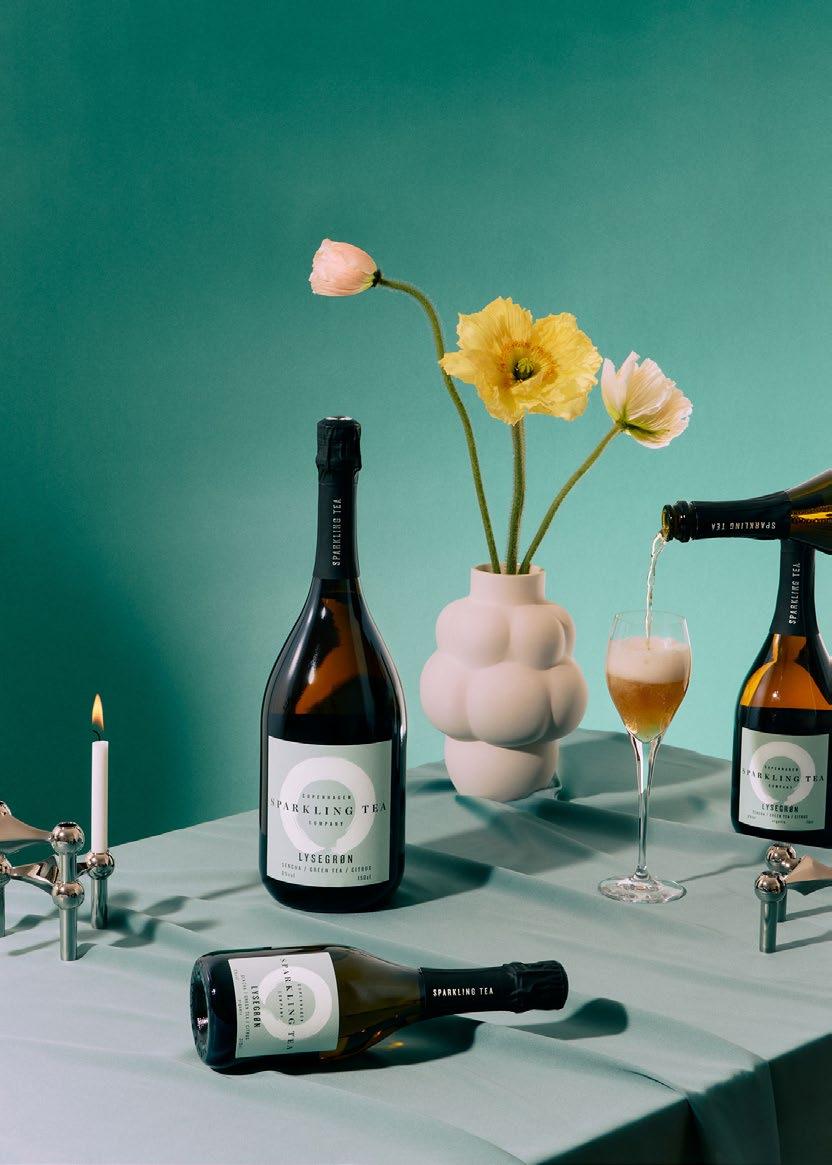

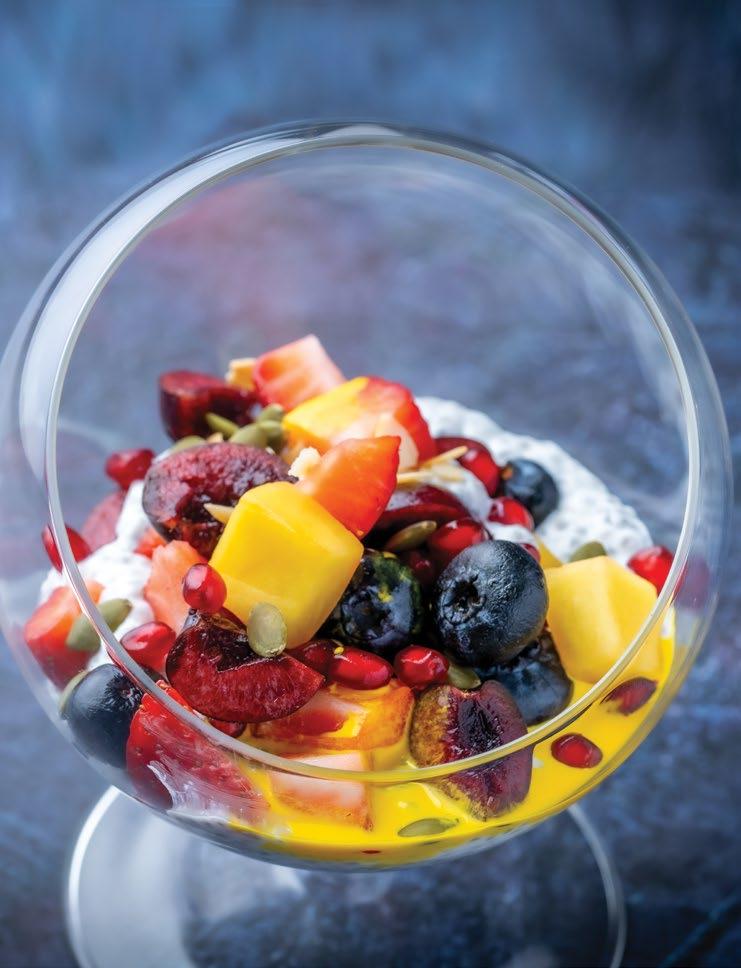


SEATING FOR SEVEN
Room for up to seven across three rows of flexible seating.






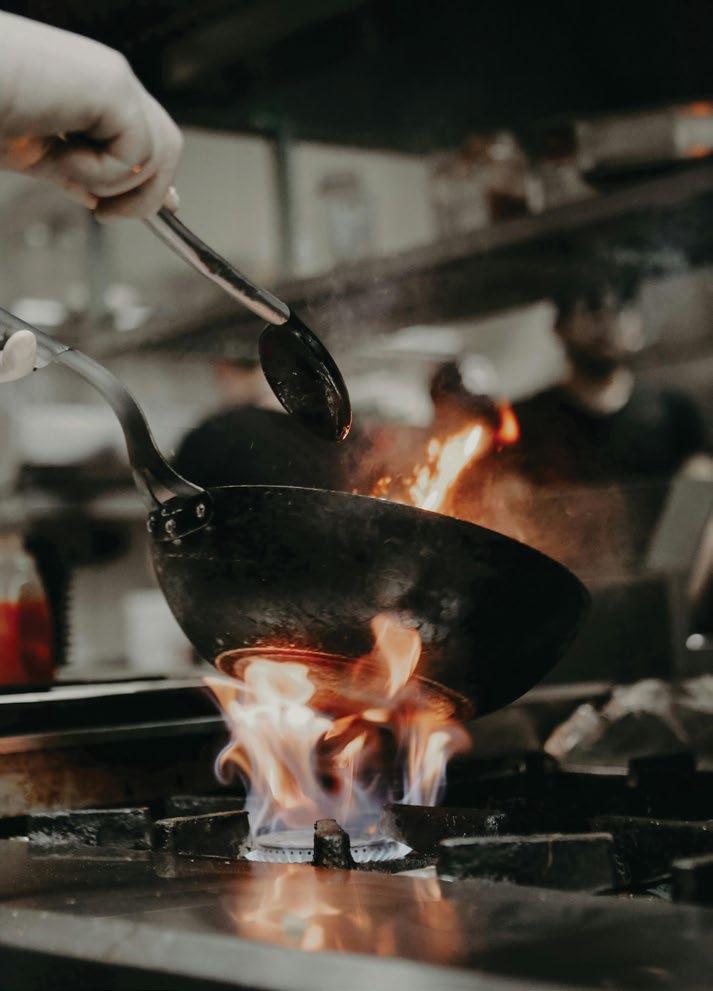


..."INTRODUCTING






Room for up to seven across three rows of flexible seating.









..."INTRODUCTING

Faisal Ahmed Aldeleigan
Chef Faisal left his comfortable life as a banker for a career as a chef consultant. His love for food was instilled by his mother, he has perfected his craft by studying cooking techniques in Europe. By establishing the Chef Faisal Consultancy, Faisal is able to not only share simple yet sophisticated dishes, but is also positioned to help restaurant businesses thrive.

Louise Sammut Louise discovered her cooking passion at a young age. She evolved into exploring flavours and techniques while experimenting by creating her own variations and developing her signature style known for its flavourful dishes and meticulous presentations. She believes that the power of food brings people together and creates lasting memories.

Paul Watters
Originally from Belfast, Northern Ireland, Paul spent over 30 years in the culinary world. His passion for cooking began at 16 and led him to incredible places like the Savoy in London and the Sydney Opera House. Being a chef has allowed Paul Watters to travel the world, explore cultures, and create unforgettable dishes— an experience he is proud to share through every plate.

Petros Skarmoutsos
A wine expert, who has called Malta home for the past seven years. Armed with a master's degree in marketing management, Petros has amassed extensive experience in the HORECA sector, excelling as an operations manager in both Greece and Malta. Known for his talent in curating impressive wine lists and cocktail menus, he has found his niche as the Wine Manager for Farsons Group since 2021.
"THE HEAT OF THE SEASON MEETS THE FIRE OF CULINARY CREATIVITY. THIS EDITION IS BURSTING WITH VIBRANT FLAVOURS, FEATURING TALENTED CHEFS WHO BRING THEIR PASSION TO THE PLATE WITH INSPIRING SEASONAL RECIPES."
PERFECTING PAELLLA
Golden, smoky, and steeped in heritage, paella is more than a dish—it’s Spain’s invitation to gather, share, and savour.

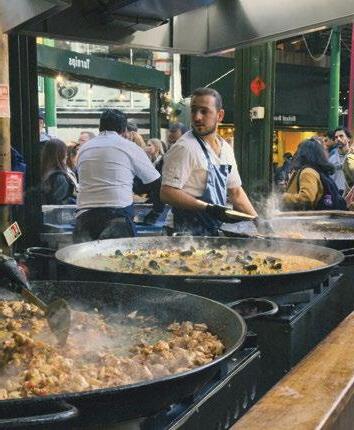
PAIN PERDU WITH CHERRIES
Bringing new life to lost bread, this cherrykissed Pain Perdu layers indulgence with every golden bite and nutty crunch.
A DECADENT GERMAN ICON
A timeless German classic, Black Forest cake layers chocolate sponge, cherries, and cream into pure, indulgent dessert perfection.
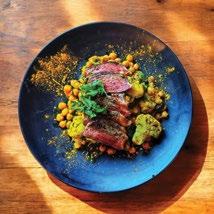
RETRO AVO TOAST
A bold remix of the classic: creamy beetroot hummus, zesty avocado, and a perfectly poached egg — fresh, vibrant, retro.


MIDDLE EASTERN FLAVOURS
Bright, aromatic spices transform simple ingredients into a vibrant, indulgent dish— perfect for weeknights or entertaining. Bold, layered, effortless.
SEASONAL
Chef Faisal is back with his seasonal recipes, inspiring us all to get into the kitchen and enjoy fresh, vibrant flavours this season.

QUINOA BOWL
A vibrant and wholesome salad combining tender grilled chicken, fresh greens, and a tangy buttermilk Parmesan dressing — perfectly balanced and full of texture.
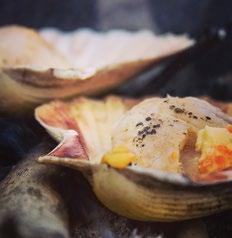

STRAWBERRY CREAM CHIA DESSERT
A light chia parfait with saffron, cardamom, berries, and mango, topped with nuts. Healthy and refreshing.
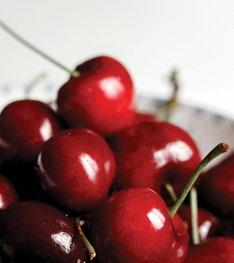
INTO THE WILD KITCHEN
Kieran Creevey reconnects us to nature, inspiring spontaneous, seasonal cooking fueled by curiosity and instinct.
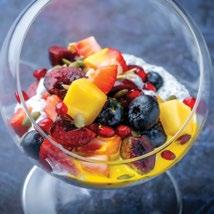
48 35 54 56 44 21
CHERRIES’ THE WORD!
Few fruits captivate like cherries — perfect fresh, baked, or in sauces. Their rich history and versatile flavor make them a timeless culinary treasure.
FOLK FOOD
Making puff pastry from scratch is meditative— flour, butter, water, and salt transform into golden, flaky layers through patience and skill.
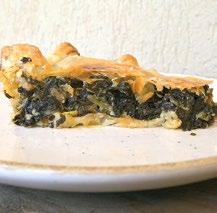
SAVOUR THE SEASON
Delicious patties combining peas, broad beans, and creamy ġbejna, seasoned with herbs and garlic for the perfect bite.
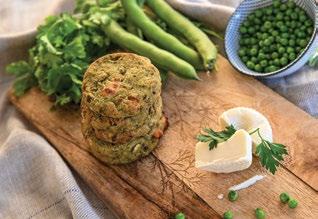


“FRESH FLAVOURS AND SIMPLE RECIPES CRAFTED TO BRIGHTEN SUNNY DAYS AND BRING PEOPLE TOGETHER FOR GOOD COMPANY AND GREAT MOMENTS.”
14. Culinary Artistry & Excellence
Xara Catering redefines events in Malta with exquisite food, personalised service, and unforgettable experiences across prestigious venues.
16. On the Bottle Petros Skarmoutsos uncorks the truth about screwcaps — revealing their evolution from underdog to a benchmark of modern wine excellence.
19. Cherrys' the Word!
Nature’s edible jewels shine this season—fresh, sweet, and steeped in history. Discover why cherries are always worth celebrating.
20. Seasonal Star: Pain Perdu
Bringing new life to lost bread, this cherry-kissed Pain Perdu layers indulgence with every golden bite and nutty crunch.
24. Sticking to Tradition
Golden, smoky, and steeped in heritage, paella is more than a dish— it’s Spain’s invitation to gather, share, and savour.
28. Inspired by the Season
Chef Faisal serves up a bright collection of summer flavour featuring fresh vibrant, dishes for sunny days.
37. Which Wines + Why?
Some white wines, like Riesling and Chardonnay, improve with age, gaining flavour and complexity... Petros Skarmoutsos explains...

38. Middle-Eastern Flavour
Bright, aromatic spices transform simple ingredients into a vibrant, indulgent dish—perfect for weeknights or entertaining. Bold, layered, effortless.
46. Into the Wild Kitchen
Kieran Creevey celebrates the ocean’s bounty with three creative foraged dishes. Foraging reconnects us to nature, inspiring spontaneous, seasonal cooking fueled by curiosity and instinct.
52. Folk Food
Making puff pastry from scratch is meditative—flour, butter, water, and salt transform into golden, flaky layers through patience and skill.
55. In Crust We Trust
Ftira started in 16th-century Malta as test breads in wood-fired ovens. Today, it’s a thick, crusty, soft bread and a beloved symbol of Maltese heritage.
56. Stay Sweet
End your reading on a sweet note. The most irresistible cherry-infused desserts await.
60. Germany’s Dessert Icon
A timeless German classic, Black Forest cake layers chocolate sponge, cherries, and cream into pure, indulgent dessert perfection.
62. Baked in Memories
Baking with Nanna as a child made lasting memories. Now, her biscotti keep her close and our story alive.

Scan the QR code and find hundreds more delicious recipes to sink your teeth into.

Under Chef Bonello’s leadership, Xara Catering has become one of Malta’s most versatile and respected catering services. The team’s ability to adapt to a diverse array of events— whether a cozy dinner for close friends or a grand celebration with hundreds of guests— has positioned Xara as a go-to partner for clients who expect nothing short of excellence. Their reputation for professionalism and creativity is matched only by their precision in execution. Despite its consistent success, Xara Catering remains committed to growth and innovation. Adrian emphasizes the importance of evolution in cuisine and technique, ensuring that the kitchen is always progressing. While the commitment to high standards never wavers, the menus are continually refreshed to reflect modern trends, innovative
cooking methods, and the evolving palates of their clientele. State-of-the-art kitchen equipment and cutting-edge culinary techniques allow Adrian and his team to push creative boundaries while staying true to the essence of Maltese gastronomy.
As it continues to grow and evolve, Xara Catering is not just serving food—it’s crafting experiences. With its perfect blend of tradition, innovation, and sustainability, Xara continues to redefine event hospitality in Malta, delivering moments that are as memorable as they are delicious.
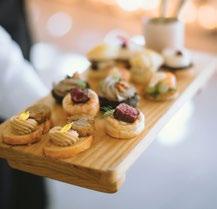

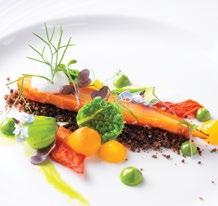

..."XARA CATERING BLENDS EXCEPTIONAL CULINARY TALENT WITH PERSONALISED SERVICE, CREATING UNFORGETTABLE FARM-TO-TABLE DINING EXPERIENCES IN MALTA."...
Petros Skarmoutsos, Wine Manager at Farsons Beverage Imports Company Ltd., shares his expert insight into one of the wine world’s most misunderstood innovations. Long dismissed as a marker of cheap wine, the screwcap has quietly become a symbol of quality, precision, and forward-thinking winemaking. Here’s why it’s time we gave it the respect it deserves.
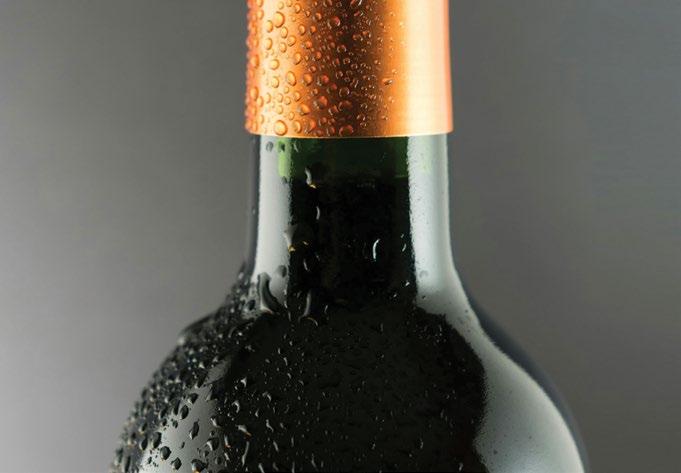
Long dismissed as the mark of cheap wine, the screwcap has quietly become a symbol of quality, precision, and innovation. Here’s why it’s time to give it the respect it deserves.
By Petros Skarmoutsos DipWSET
When it comes to wine, few debates stir the glass quite like the one over closures. For decades, the natural, romantic, classic, with a satisfying pop cork, has reigned supreme. Meanwhile, its upstart cousin, the screwcap, has battled an image problem. Dismissed by most as a marker of cheap, supermarket destined or inferior wine, the screwcap has long been misunderstood and a stranger to many restaurants’ wine lists. But it’s time to uncork the truth: screwcaps are not just for low-quality wine and in many cases, they might actually be the superior choice.
The Evolution of the Screwcap Screwcaps first gained serious traction in the 1970s, particularly in Australia and New Zealand, where winemakers were frustrated by the unpredictability of cork. In 2001, Villa Maria was one of the first wineries self-proclaimed ‘100% cork free’, following years of frustration about cork failures and committed to deliver consistent quality for each and every bottle sold around the world. Unlike cork, which is a natural material with inherent variability, screwcaps provide a consistent seal. The most recognized brand of wine screwcap is Stelvin, developed in the 1960s in France and now widely used by quality-focused wineries around the world. Stelvin closures revolutionized modern winemaking by offering an elegant, airtight solution that maintains wine integrity.
However, despite its technical superiority, the wine world, especially in Old World regions, clung to tradition. Cork is culture; cork is class. Science in the Bottle
A 10-year study by the Australian Wine Research Institute (AWRI) compared the aging potential of wines sealed under cork, synthetic closures, and screwcaps. The findings? Wines under screwcap retained freshness and fruit vibrancy better than their cork-sealed counterparts, which often suffered from oxidation or spoilage. For white wines in particular, screwcaps preserved the wine's intended profile with remarkable fidelity and consistency. >>
One of the most compelling advantages of the screwcap is its immunity to cork taint, formally known as TCA (2,4,6-trichloroanisole). TCA can impart a musty, damp cardboard aroma and flavour to wine, rendering it undrinkable. Estimates suggest that up to 3–5% of wines sealed under natural cork are affected by TCA to some degree. Screwcaps on the other hand, virtually eliminate this risk, offering peace of mind for both winemakers and consumers. Cork has a few other downsides that are rarely mentioned. It must stay moist to maintain a proper seal, hence the need to store bottles horizontally. A dried-out cork can shrink, allowing oxygen in and damaging the wine, therefore proper storage and provenance is of paramount importance. And let’s not forget practicality: screwcaps are hassle-free, especially when you don’t finish the bottle. A quick twist reseals it perfectly, making it ideal for enjoying over several days without losing much in quality.
How about ageing?
One of the lingering myths is that wines under screwcap cannot age. But this too has been disproven. In fact, screwcaps can support graceful aging, especially when designed to allow minuscule amounts of oxygen ingress, a process known as controlled oxygen transmission. Stelvin closures, for instance, come

in different liner types to allow winemakers precise control over oxygen exchange, mimicking the aging curve of a cork without its unpredictability!
Today, some of the world’s most prestigious wineries use screwcaps. In New Zealand, nearly 99% of wines are sealed with them, including iconic producers Villa Maria and Cloudy Bay, known for high-quality Sauvignon Blancs and Pinot Noirs. In Australia, legendary names like Henschke have transitioned their premium wine, including their flagship Hill of Grace Shiraz, to screwcap, citing superior long-term quality and consistency. Penfolds and Yalumba have also been leaders in this closure revolution.
Even in the U.S., where cork tradition runs deep, acclaimed wineries have recently leaned into screwcap closures.
And while Old World wine regions have been slower to shift, the tide is turning. In Italy, producers in Alto Adige and Sicily have begun using screwcaps, particularly for fresh white wines meant to highlight fruit and minerality. Many producers offer their importers the choice, to bottle the wines with either cork or screwcap, slowly collecting data and monitoring the

preference shift. In Bordeaux, forward-thinking estates in regions like Entre-Deux-Mers are experimenting with screwcaps for early-drinking whites, citing consumer convenience and quality control.
Let’s put it plainly: screwcap does not equal cheap. It equals consistency, protection, and increasingly, quality. Cork will always have its place, with advancing technology that ensures more consistent cork quality, and of course because it retains that ceremonial charm of opening a fine wine bottle. In a fine-dining restaurant, the theatrical pull of a corkscrew followed by the gentle pop is a sensory ritual that many still treasure. The screwcap, while practical, inevitably strips away a touch of that magic.
Still, for everyday drinking, travel ease, and ensuring your wine tastes as the winemaker intended—without risk of taint, oxidation, or storage fuss—the screwcap shines. So next time you hesitate to pick up a screwcapped bottle for your dinner party or wine cellar, remember: it’s what’s inside that counts.
Cheers to myths busted—and wines wellpreserved!

"SCREWCAP DOES NOT EQUAL CHEAP. IT EQUALS CONSISTENCY, PROTECTION, AND INCREASINGLY, QUALITY."

"Life is just a bowl of cherries."
— Lew Brown (1931)
Words: Marcie Olson, Served Kitchen

Few fruits capture the imagination (and appetite) quite like the cherry. Whether piled into a luscious tart, simmered into a sauce, or simply popped into the mouth one by one, cherries are the ultimate expression of nature’s edible jewels. But beyond their delicious flavor and eye-catching color lies a rich history that spans thousands of years, many continents, and a whole lot of culinary creativity.
The story of the cherry begins in ancient Asia and Europe. Wild cherry trees (Prunus avium, or sweet cherry, and Prunus cerasus, or sour cherry) are native to parts of Europe, Western Asia, and North Africa. Archaeological evidence suggests that cherries were eaten by prehistoric people as far back as the Stone Age.
But it was in ancient Rome that cherries really took root in cultivated agriculture. The Roman general Lucius Licinius Lucullus, known for his lavish feasts, is often credited with introducing cherries to Rome around 72 BCE after military campaigns in what is now Turkey. The town of Cerasus (modern-day Giresun) on the Black Sea is believed to be the namesake of the fruit. The Romans quickly fell in love with cherries, spreading them across the empire — and eventually, much of Europe.
As centuries passed, cherries continued their migration. Monastic gardens in medieval Europe cultivated cherries both for their fruit and their beauty; the cherry blossom’s fleeting bloom inspired poetry long before it became a cultural symbol in Japan.
European colonists brought cherry trees to the Americas in the 1600s. The fruit thrived in certain climates, particularly in Michigan, Washington, and Oregon — now major cherry-producing
regions. Today, the U.S. is one of the world’s top cherry exporters, with Michigan alone producing over 75% of the country’s tart cherries.
Meanwhile, in Japan, sakura (cherry blossoms) became a national obsession. Though the cherry blossom tree produces inedible fruit, its delicate beauty and symbolism — the fleeting nature of life — are celebrated during hanami, or flowerviewing festivals, which draw millions of visitors each spring.
Sweet vs. Sour Cherries come in many varieties, but they largely fall into two categories: sweet (Prunus avium) and sour (Prunus cerasus).
Sweet cherries — think Bing, Rainier, and Lapins — are the ones you snack on fresh by the handful. They’re firm, juicy, and often dark red or golden with a blush. Sweet cherries ripen in early summer and have a short window of perfection, making them a highly anticipated seasonal treat.
Sour cherries, or tart cherries — like the famed Montmorency — are beloved by bakers and chefs. Their bright acidity cuts through sugar beautifully, making them ideal for pies, preserves, sauces, and spirits. In fact, Kirschwasser (cherry brandy), used in the iconic Black Forest Cake, relies on sour cherries for its deep, complex flavor.
What makes cherries such a favorite in kitchens around the world? In a word: versatility.
Cherries can swing from sweet to savory without missing a beat. They shine in classics like cherry clafoutis — a rustic French dessert where whole cherries are baked in a flan-like batter — or American cherry pie, the ultimate Fourth of July table star. But they’re equally at home in more modern and savory dishes: paired with duck or pork, stirred into salads, or used to balance rich cheeses.
Cherries also feature heavily in liquid form. Beyond Kirsch, cherries inspire syrups, shrubs, liqueurs, and even beer. Belgian Kriek lambic — a spontaneously fermented beer aged with cherries — is a cult favorite among craft beer enthusiasts.
And of course, who can forget the iconic cocktail cherry? Though the bright-red maraschino of the past was known more for its artificial sweetness, today’s artisanal cocktail cherries (often preserved in real brandy or bourbon) are a world apart — rich, dark, and packed with grown-up flavor.
Cherries don’t just taste good — they’re good for you. They’re loaded with antioxidants, particularly anthocyanins (which give cherries their red hue), and boast anti-inflammatory properties. Studies suggest that tart cherry juice can aid in muscle recovery, improve sleep, and even help reduce arthritis symptoms.
Low in calories, high in vitamin C, fiber, and potassium, cherries are a guilt-free indulgence whether eaten fresh or cooked.
The catch with cherries is their fleeting season. Fresh cherries hit markets in late spring to midsummer, depending on the variety and region. This brief availability is part of their charm — you simply can’t enjoy a sun-warmed cherry plucked straight from the tree any other time of year.
When you do get your hands on them, think beyond the bowl. Bake them, pickle them, pair them with rich meats or chocolate. Or simply eat them out of hand, appreciating the fact that each cherry carries with it a story stretching back thousands of years — from ancient groves to your kitchen.
In a food world obsessed with trends, cherries remain delightfully timeless. Proof, perhaps, that the best things — like the best cherries — are worth the wait.
Prep/Cook time: 35min, Serves: 1
Few things evoke comfort like Pain Perdu—the French name for what many know as “French toast.” Literally meaning lost bread, Pain Perdu was originally a clever way to breathe new life into stale loaves. Today, it’s been elevated to a brunch and dessert favorite, and this cherrykissed version transforms it into something truly special.
At its heart is a slice of rich brioche, soaked in a
For the Cream Frosting:
5 tbsp cooking cream
1/2 tsp corn flour
1 tbsp white sugar
1 tsp vanilla essence
3 tbsp whipping cream
For the Caramelised Walnuts:
2 tsp white sugar
Pinch sea salt
4 tsp walnuts
1 tsp butter
For the Cherry Sauce:
Few frozen cherries
6 tsp light brown sugar
Pinch sea salt
3 tbsp strawberry puree
1 +1/2 tbsp raspberry puree
spiced batter of cream, egg, and a whisper of cinnamon and cardamom. Toasted to golden perfection, it forms the ideal canvas for layers of indulgence.
For texture, scatter over caramelised walnuts, made by melting sugar and butter into a golden glaze that clings to the nutty crunch. A final flourish of toasted almond slices adds another delightful layer.
For the Batter:
1 egg
3 tbsp cooking cream
1 tbsp white sugar
1 1/2 tbsp milk
Pinch cinnamon powder
Pinch cardamom powder
Pinch sea salt
For the Toast Assembly:
1 slice brioche loaf
5 tbsp cream frosting
2 tbsp cherry sauce
1 cherry
A sprinkle of toasted almond slices
A sprinkle of caramelised walnuts
Method
Cream Frosting:
Whip the whipping cream. Cook the cooking cream, corn flour, sugar, and vanilla into custard. Fold in whipped cream.
Topped with a single cherry, this dish is as elegant as it is satisfying. Whether served at a brunch gathering or as a decadent dessert, Pan Perdu with Cherries is a testament to the magic that happens when humble ingredients meet thoughtful technique.
Caramelised Walnuts:
Melt the sugar, add the walnuts, and butter and caramelise.
Cherry Sauce:
Cook the cherries, sugar, strawberries, raspberries, and salt for 5 mins.
Batter:
Whisk the egg, cream, milk, sugar, and spices.
Assembly:
Dip1 brioche slice in batter, toast.
Top with the frosting, sauce, cherry, almonds, and walnuts.
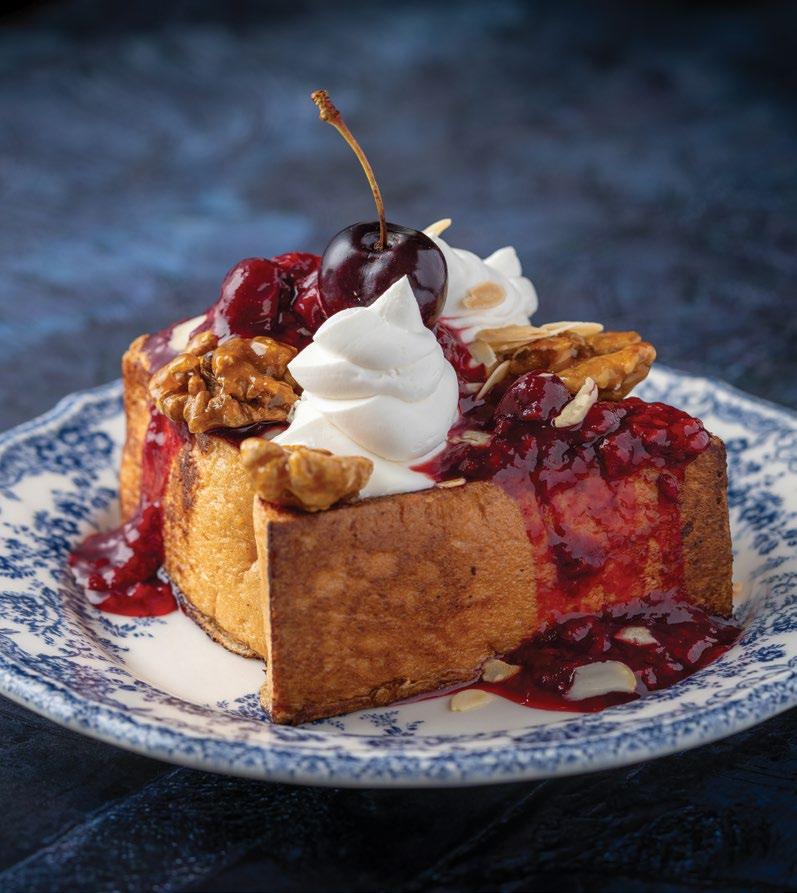
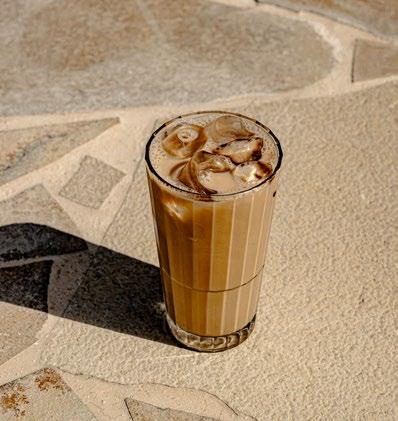



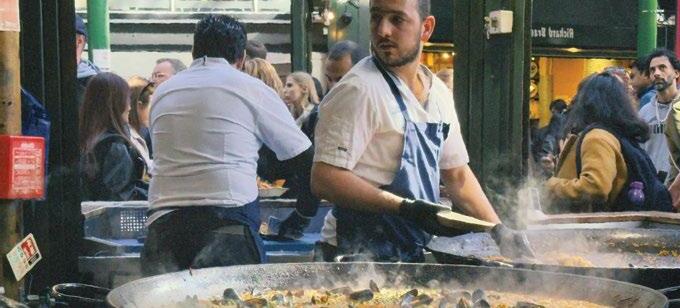
Few dishes evoke the spirit of Spain quite like paella. A pan of saffron-scented rice, flecked with vegetables, meats, or seafood, paella is both a culinary delight and a cultural ritual. But behind its golden allure lies a rich story that begins in the fields of Valencia and continues to capture the imaginations—and palates—of food lovers worldwide.
The word paella originally referred to the shallow, wide pan in which the dish is cooked—a vessel designed to maximise surface area, allowing the rice to absorb flavor and form the coveted socarrat, the caramelised layer at the bottom. The dish itself emerged in Valencia around the 19th century, born from necessity and ingenuity. Valencian farm workers, cooking over open fires in the fields, would combine short-grain rice with whatever
was at hand: rabbit, chicken, snails, seasonal vegetables, and fragrant saffron. The result was a rustic, hearty meal, perfect for sharing.
As Spain’s culinary tapestry expanded, so did paella’s variations. Along the coast, fishermen transformed it with the bounty of the Mediterranean sea—shrimp, mussels, clams, and squid—giving rise to paella de marisco (seafood paella). Today, there’s also paella mixta, a marriage of land and sea, and countless vegetarian versions that celebrate the freshest produce.
Yet paella is more than the sum of its ingredients. It’s a dish intrinsically tied to community as families and friends gather around an outdoor fire or oversized stovetop pan, sipping wine as the rice slowly simmers and the aromas fill the
air. When ready, the paella is brought to the table in its pan, as a centerpiece to be admired and enjoyed together.
This sense of ritual and celebration is what elevates paella from a simple rice dish to a symbol of Spanish conviviality. And while modern chefs around the world have embraced creative interpretations, Valencians remain staunch guardians of tradition—insisting that true paella Valenciana adheres to a time-honored list of ingredients and techniques.
Whether enjoyed in a bustling seaside restaurant or lovingly prepared at home, paella is a dish that invites you to slow down, savor each bite, and celebrate life’s simple pleasures. It is, after all, more than food—it is an experience.
"WHETHER YOU STICK TO TRADITION OR RIFF WITH YOUR FAVOURITE FLAVOURS, PAELLA IS ALL ABOUT BRINGING PEOPLE TOGETHER."
How to Nail That Crispy Bottom (Socarrat)
1. Don’t stir once the liquid is mostly absorbed—trust the process!
2. Toward the end of cooking, once liquid is mostly absorbed, you want a light crackling sound — this is the socarrat forming.
3. When you hear this sound, don’t panic! Just let it go for 1–2 minutes — this gives you that coveted crispy bottom.
38–40 cm (15–16") 4–6 people
46–50 cm (18–20") 6–8 people
55–60 cm (22–24") 10–12 people
65+ cm (26" and up) 14+ people
Use a 40cm paella pan which works well on an open fire as well as your large home burner.
1. The fire should be wide, not tall — a good bed of coals or a wood fire that’s burned down a bit is perfect. You don’t want big flames licking up the sides constantly.
2. Adjust heat by moving the pan — pull it slightly on or off the hottest part of the fire as needed.
3. Practice makes perfect — cooking on an open fire is more art than science! Start with a medium-sized pan (around 40–50 cm) the first time.
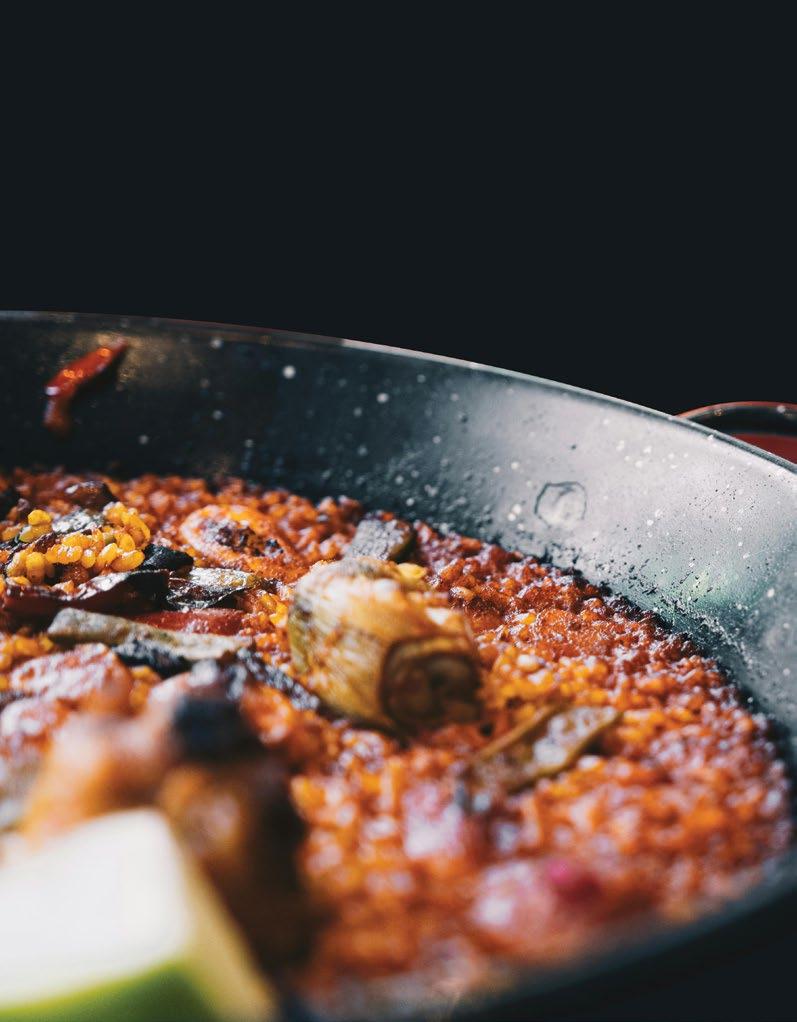
Prep/Cook time: 1hr – Serves: 4-6

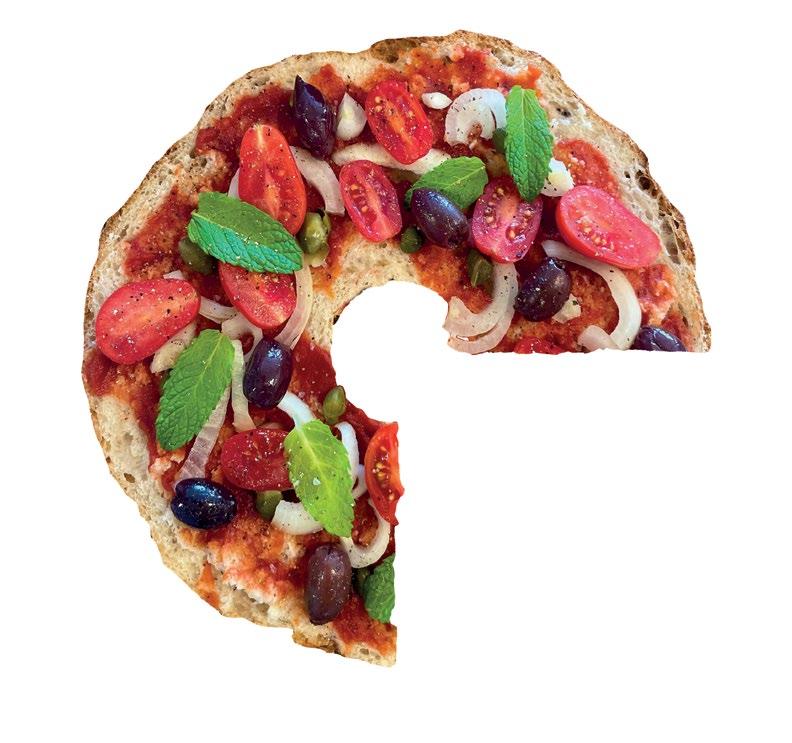
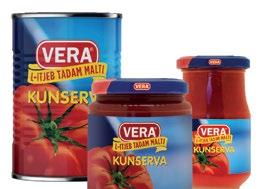

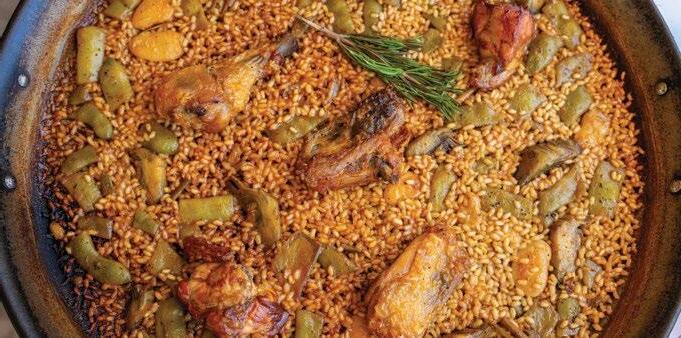
Ingredients:
500g chicken, cut into pieces
300g rabbit, cut into pieces (optional but traditional)
200g green beans (judía verde or flat green beans)
100g garrofón (white butter beans or large lima beans)
2 medium tomatoes, diced
400g (2 cups) short-grain Spanish rice (arroz bomba or Calasparra)
1.2–1.5 liters (5–6 cups) chicken or meat broth
A generous pinch of saffron threads
1 tsp sweet Spanish paprika
Salt, to taste
Fresh rosemary sprig
Extra virgin olive oil
Lemon wedges to garnish
A few snails (optional)
Method:
Heat olive oil in a large paella pan (minimum 40cm/16in for this quantity) over medium-high heat.
Add chicken and rabbit pieces. Salt well. Fry until golden brown on all sides—this step is key for building flavor. Take your time here (about 10–15 minutes).
Add the green beans and garrofón. Sauté for a few minutes until slightly tender. Push the meat and veg to the edges and add the grated tomato to the center. Cook until the tomato reduces and thickens, about 5 minutes. Sprinkle in the paprika and stir everything together.
Pour in the broth (or water). Add saffron and a little more salt. Taste and adjust seasoning—you want the broth slightly salty since the rice will absorb it. Bring to a boil and simmer for 10 minutes.
Evenly distribute the rice across the pan—do not stir after this point.
Simmer uncovered on medium heat for about 8–10 minutes. Then reduce heat to low and cook another 8–10 minutes. Rotate the pan occasionally for even cooking.
Toward the end, if you want that prized socarrat, increase the heat for 1–2 minutes until you hear a gentle crackling (don’t burn it!).
Remove from heat. Cover loosely with a clean kitchen towel or foil and let rest for 5 minutes. Bring the pan to the table and serve directly from it.
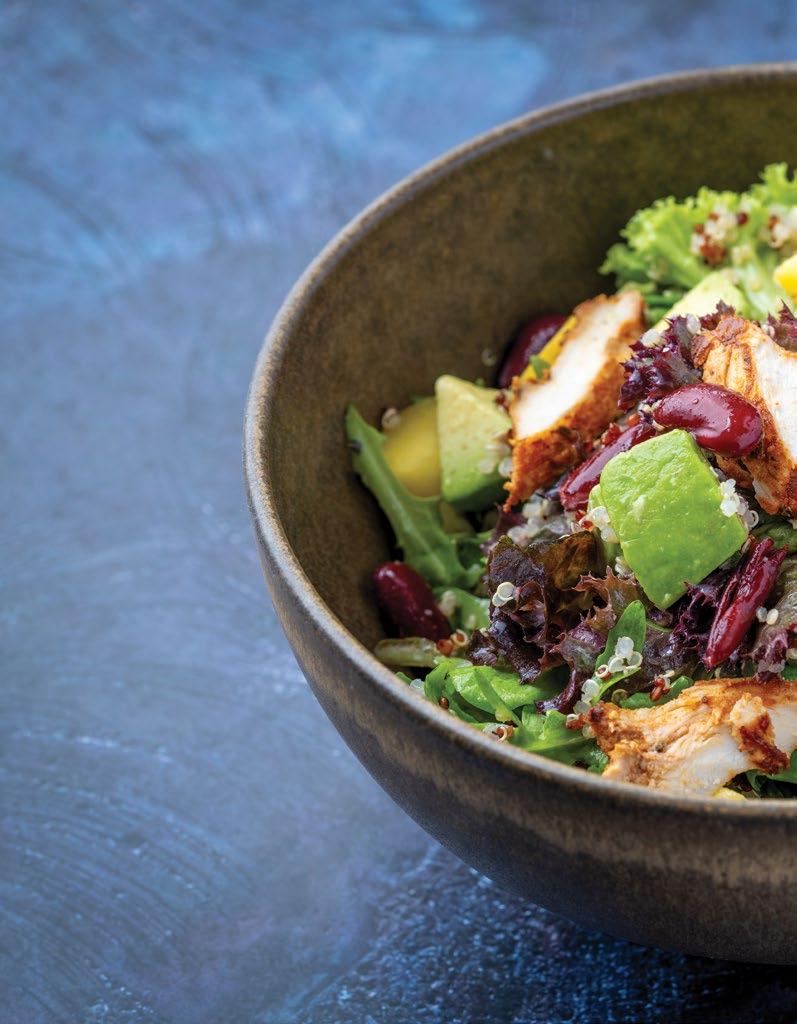
CHEF FAISAL SERVES UP A BRIGHT COLLECTION OF SUMMER FLAVOUR FEATURING FRESH VIBRANT, DISHES PERFECT FOR SUNNY DAYS AND LAID-BACK GATHERINGS. LIGHT, SEASONAL, AND SURE TO IMPRESS.
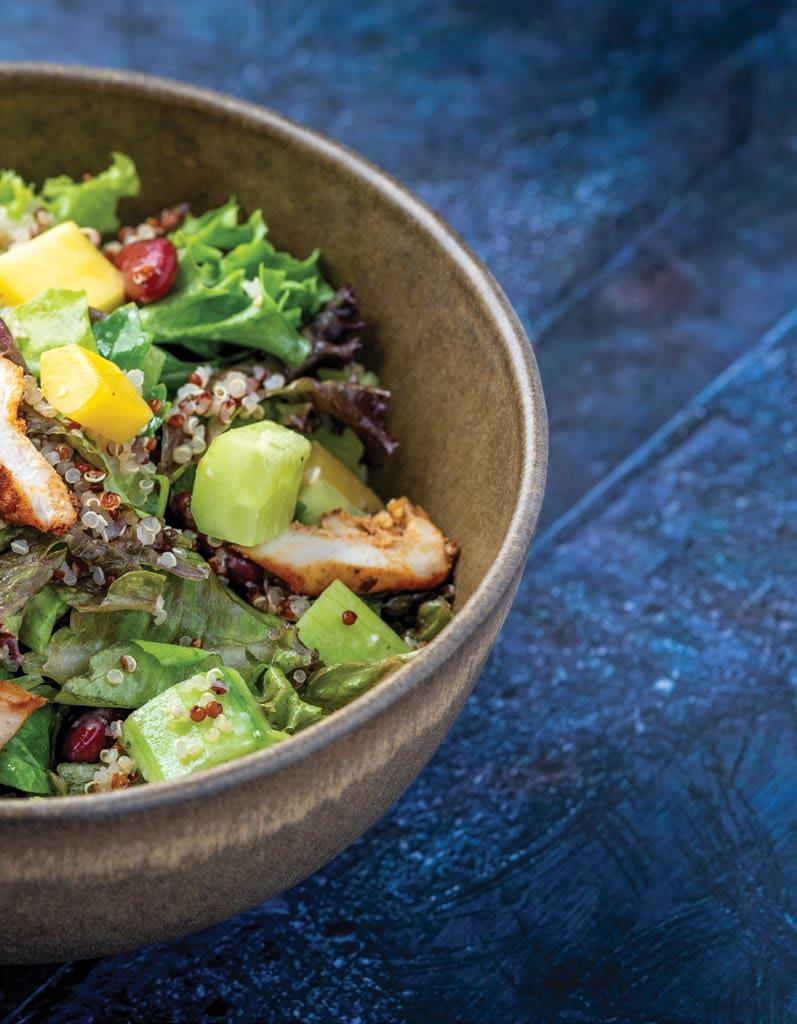
Ingredients
6 tbsp mayonnaise
3 tsp brown sugar
Juice of 1/2 a lemon
3 tsp spicy brown mustard
Pinch sea salt
Pinch dry oregano
For the Smashed Beef Patty
2 1/2 tbsp brisket (wagyu)
1 tbsp wagyu fat
2 1/2 tbsp beef chuck
For the Rocket Mix
A few leaves of rocket
A few cilantro leaves
Pinch mixed sesame
Pinch black pepper powder
Pinch sea salt
For the Poached Egg
250 ml water
A dash of white vinegar
2 eggs
For the Smashed Eggs Toast
1 slice brioche loaf
3 tbsp spicy mustard mayo
100gm smashed beef patty
2 poached eggs
1 cup of rocket mix
Method
Spicy Mustard Mayo
Combine mayonnaise, brown sugar, lemon juice, spicy brown mustard, sea salt, and dry oregano in a bowl. Mix well.
Smashed Beef Patty
Mince the brisket, wagyu fat, and beef chuck. Form into a patty. Grill 2 minutes each side.
Rocket Mix
Mix the rocket, cilantro, sesame, black pepper, and sea salt.
Poached Egg
Boil the water with vinegar. Add 2 eggs, cover, and poach on low heat for 4 minutes.
Smashed Eggs Toast
Toast 1 slice brioche. Spread with the mustard mayo, top with the beef patty, 2 poached eggs, and rocket mix.
"ELEVATED BRUNCH MEETS BOLD FLAVOUR—JUICY WAGYU, SILKY EGGS, AND MUSTARD MAYO PILED HIGH ON BRIOCHE FOR SERIOUS INDULGENCE."
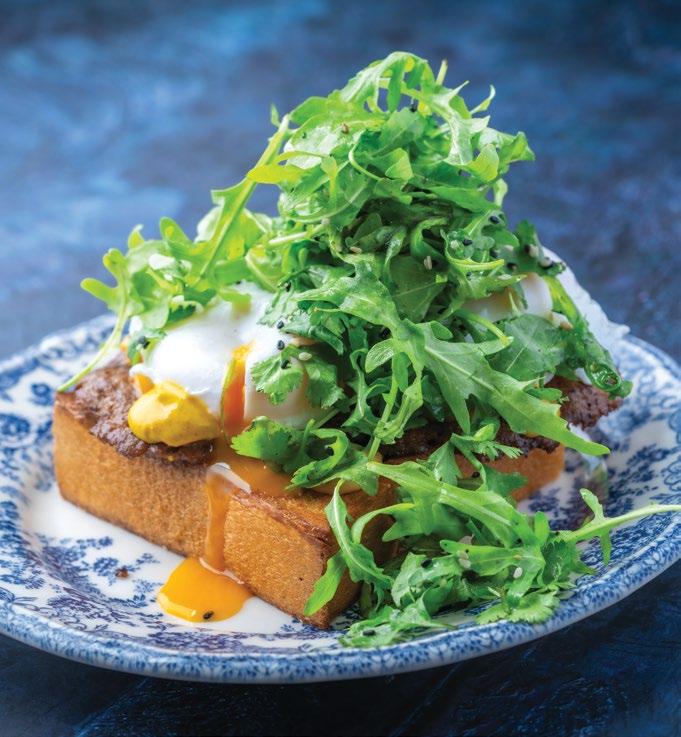
By Chef Faisal – Prep/cook: 20mins – Serves 1
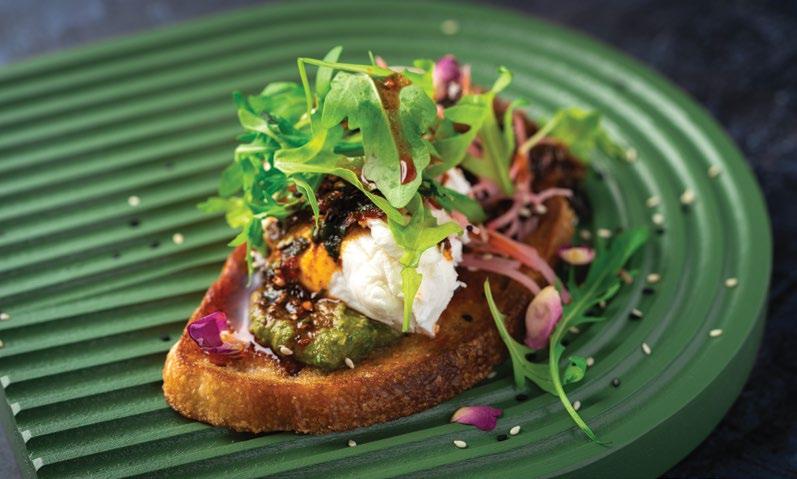
Ingredients
2 medium sized boiled beetroots
2 tbsp boiled chickpeas
2 tbsp olive oil
1/2 a lemon juiced
1/4 tsp cumin powder
Pinch sea salt
For the Avocado Mix
1 ripe avocado
Pinch sea salt
Pinch black pepper powder
1/2 a lemon juiced
For the Poached Egg
250ml water
Dash of vinegar
1 egg
For the Toast Assembly
1 slice multigrain sourdough
6 tbsp beetroot hummus
8 tbsp mashed avocado mix
1 poached egg
Sprinkle of microgreens
Method
Beetroot Hummus
Blend the beetroot, chickpeas, olive oil, lemon juice, cumin, and tsp salt.
Avocado Mix
Mash 1 avocado with the salt, tsp pepper, and lemon juice.
Poached Egg
Poach 1 egg in the water with vinegar.
Assembly
Spread the hummus on 1 slice sourdough, top with the avocado, the egg, and microgreens.
Cook/Prep time: 30min – Serves: 1
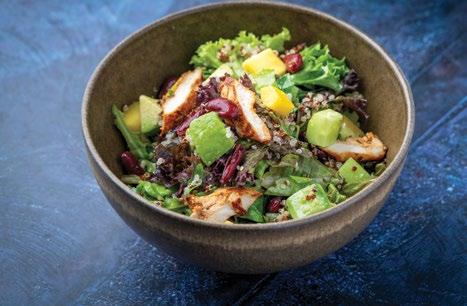
Ingredients
For the Buttermilk
30ml milk
1 tsp yogurt
1/2 tsp white vinegar
For the Buttermilk Parmesan Dressing
30 ml buttermilk
1 tbsp Parmesan cheese
¼ tsp sea salt
Pinch white pepper powder
Pinch dry basil leaves
2 tsp apple cider vinegar
1 tsp honey
20g Greek yogurt
For the Chicken Marinade
60g chicken breast
¼ tsp sea salt
Pinch white pepper powder
½ tsp smoked paprika powder
1 tsp mustard paste
2 tsp corn oil
For the Quinoa Bowl Assembly
2 handful Lollo Rosso
1 1/2 handful arugula
50g kidney beans
1/2 an avocado
100g grilled chicken
30g boiled red quinoa
30g boiled white quinoa
Sprinkle sunflower seeds
1/4 of a mango cut in cubes
1/4 cucumber cut in cubes
50ml Buttermilk Parmesan dressing
Method
Prepare the Buttermilk
Whisk together the milk, yogurt, and white vinegar until smooth. Set aside.
Make the Buttermilk Parmesan Dressing
Combine all dressing ingredients in a blender and blend for 1 minute until smooth.
Marinate and Grill the Chicken
Slice the chicken breast and marinate it with sea salt, white pepper powder, smoked paprika, mustard paste, and corn oil. Grill on both sides for approximately 2 minutes per side. Once cooked, slice into julienne strips.
Assemble the Quinoa Bowl
In a large mixing bowl, combine Lollo Rosso, arugula, kidney beans, avocado, both red and white quinoa, mango cubes, and cucumber cubes. Toss with the Buttermilk Parmesan dressing. Top with grilled chicken and garnish with sunflower seeds.
Savoring the Dish
Enjoy a fresh, wholesome salad bursting with vibrant greens, creamy tangy dressing, and tender grilled chicken—perfectly balanced with zesty quinoa and crisp vegetables.
"BRIGHT, BOLD, + PERFECTLY BALANCED – BRINGRING A SWEET TWIST TO YOUR TABLE"
What makes this salad shine is its balance — each ingredient complements the other without overpowering. Toasted walnuts or candied pecans add a welcome crunch, while thinly sliced red onions lend just the right hint of bite. A pinch of sea salt and a grind of black pepper tie it all together, elevating every mouthful.
Ingredients
3 tbsp olive oil
1½ tsp yellow mustard paste
Pinch sea salt
Pinch black pepper powder
1 tsp balsamic vinegar
1 tsp cherry puree
1 tsp honey
Pinch dry basil leaves
For the Caramelised Walnuts
1 tsp white sugar
Pinch sea salt
2 walnuts
1 tsp butter
Perfect as a refreshing starter or a light lunch, this salad is summer on a plate — bold in flavour, gorgeous in colour, and ready in minutes. Whether you’re hosting a garden brunch or need a weekday pick-me-up, the Cherry Feta Salad delivers on freshness and flair with minimal effort.
Pair it with a chilled rosé or sparkling water with citrus, and you’ve got a dish that’s as Instagrammable as it is irresistible.
For the Feta Spinach Salad
Few baby spinach leaves
Few rocket leaves
6 slices red radish
1/4 iceberg lettuce
2 tbsp feta cheese
1 1/2 tsp caramelised walnuts
3 cherries
20gm red cabbage
2 tbsp cherry balsamic dressing
Method
Cherry Balsamic Dressing
Blend the olive oil, mustard, vinegar, cherry puree, honey, and seasonings.
Caramelised Walnuts
Melt the sugar in pan, add walnuts, and butter. Stir until caramelised.
Feta Spinach Salad
Toss the spinach, rocket, radish slices, lettuce, and cabbage with dressing. Garnish with feta, walnuts, and cherries.
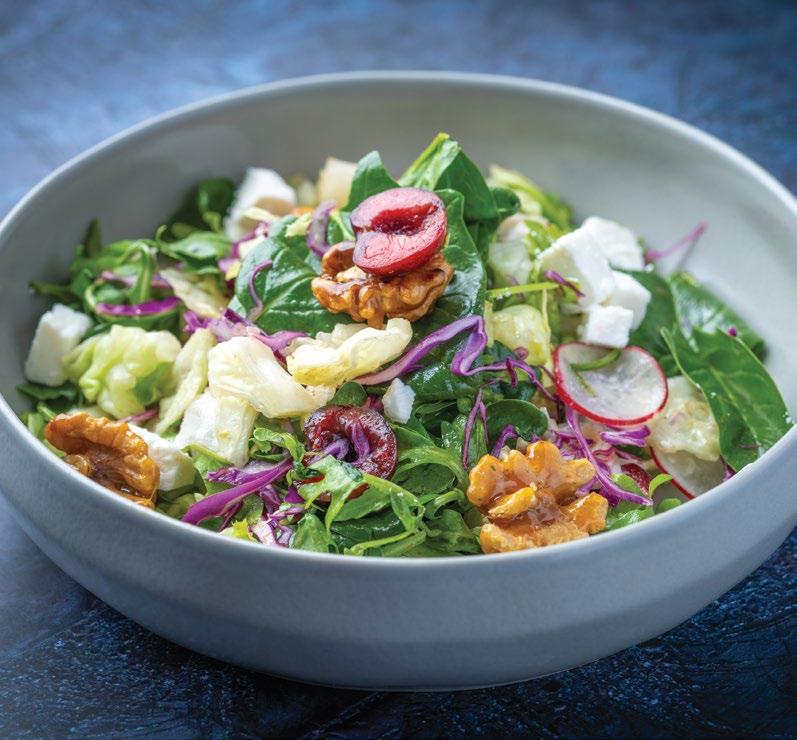
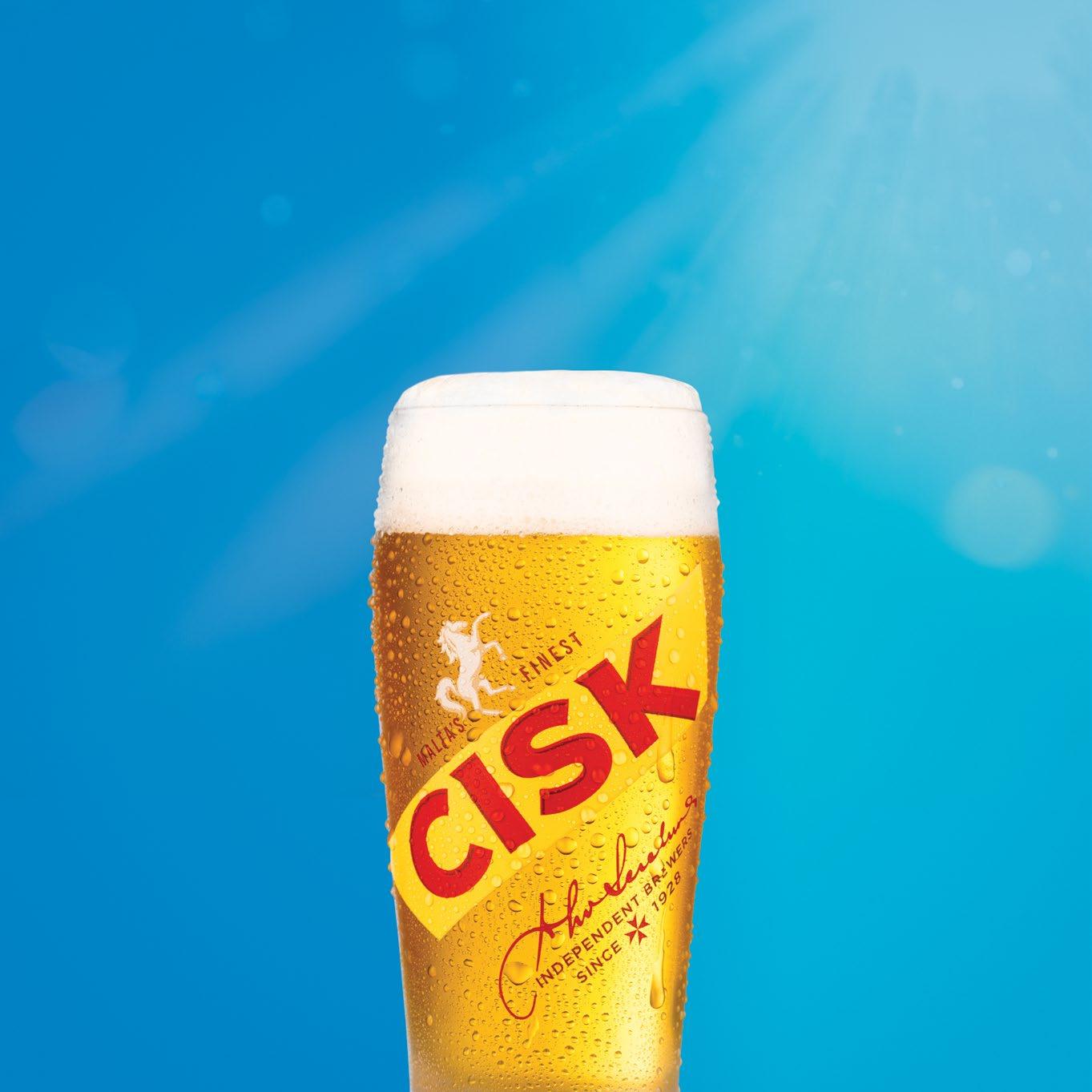
DISCOVER HOW CERTAIN WHITE VARIETIES DEVELOP RICH, COMPLEX FLAVOURS OVER TIME, TRANSFORMING FROM FRESH AND VIBRANT TO DEEPLY LAYERED. HERE'S HOW TO APPRECIATE THESE HIDDEN GEMS.

given me old wine!” she exclaimed, waving the

Words: Petros Skarmoutsos
age, and they transform over time into deeply layered, textured, and food-friendly gems. What gives these wines their aging potential? It comes down to quality and balance. High acidity, solid structure, and expert winemaking are essential ingredients. Riesling, like the one that caused such a stir at the festival, is one of the most age-worthy grapes in the world. But it’s joined by an impressive line-up of other varieties and regions: Chenin Blanc in Savennières, Loire Valley is a legendary wine to age; Timorasso from Piedmont, with its richness and mineral backbone; Assyrtiko from Santorini, offering laser-sharp acidity and a distinct saline edge; Petite Arvine from Aosta and the Swiss Alps, known for its tension and floral-citrus profile; and top-tier Napa Valley Chardonnay, which can evolve from lush and oaky to refined and nutty with time. Then there’s the great white wines of Burgundy, where Chardonnay reveals stunning aging potential in the right terroirs. Italy offers more hidden gems—Trebbiano di Soave and Verdicchio dei Castelli di Jesi are both capable of surprising longevity, evolving into layered, textured wines with notes of almonds, herbs, and flinty minerality. White Grenache, Semillon and so many others can really surprise you with the way they evolve!
As these wines mature, they reveal new dimensions. Fruit notes mellow, giving way to layers of honey, dried herbs, roasted nuts, and subtle earthiness. Their texture deepens. Their aromas become more nuanced. And they become extraordinary companions at the table. Developed white wines offer exciting food pairing opportunities thanks to their complexity and savoury edge. They often show more earthy, nutty, and saline notes, making them ideal with dishes that might overpower a younger wine—think roast chicken with wild mushrooms, aged cheeses, risottos with truffle, or even pork tenderloin with a nut-based sauce. These are wines that speak to the plate as much as they do to the glass.
The “perfect moment” to drink a wine, is deeply personal. Some people love the vibrant energy of youth, while others are drawn to the mellow depth of maturity. Some wines are great as an aperitif and others crave for some good, hearty food. There’s no right answer really, it’s about what speaks to your palate. But once you discover the magic of a white wine that’s been given time, it can change the way you experience what’s in your glass.
made for early drinking. Their charm lies in their freshness and vibrancy. But there’s another side

But even the finest white wine won’t fulfill its aging potential without the right care. Proper storage—cool, dark, and stable—is crucial. Temperature fluctuations or exposure to light can flatten a wine long before it reaches its peak.
So next time you encounter a bottle with a little age, don’t be so quick to judge it by the year on the label. Swirl, sip, and allow it to tell its story. You might just find that old wine has more to say than you ever expected.
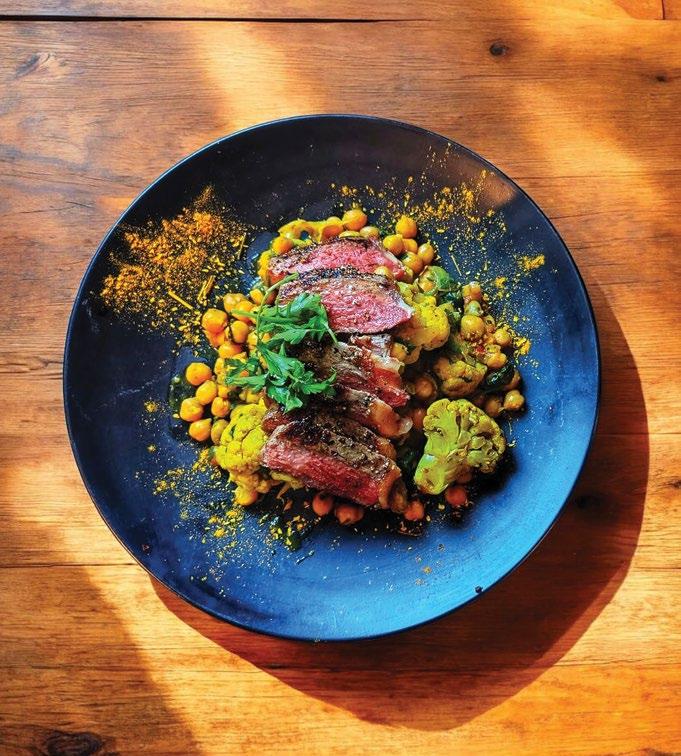

TENDER SIRLOIN STEAK MEETS A HEARTY CHICKPEA AND CAULIFLOWER SALAD IN THIS BOLD, FLAVOUR-PACKED DISH. ROASTED CAULIFLOWER AND PROTEIN-RICH CHICKPEAS ARE TOSSED WITH CHOPPED FLAT-LEAF PARSLEY, CRUSHED GARLIC, AND A ZESTY SQUEEZE OF LEMON, CREATING A FRESH AND EARTHY BASE. THE WARM, AROMATIC BLEND OF TURMERIC AND MADRAS CURRY POWDER ADDS A VIBRANT TWIST, INFUSING THE VEGETABLES WITH GOLDEN COLOR AND RICH, SPICED DEPTH.
Ingredients
1 Sirloin steak
1 can of chickpeas (drained and rinsed)
6 cauliflower florets
½ bunch flat-leaf parsley, chopped
1 lemon
1 clove of garlic, crushed
1 tsp turmeric
1 tbsp Madras curry powder
Olive oil (for drizzling)
Salt and cracked black pepper
Method
Start by preheating your oven to 180°C (350°F). Place two medium pans over medium-high heat. Drizzle a little olive oil over the sirloin steak, season well with salt and cracked black pepper, and massage it into both sides.
Once the first pan is hot, add the steak and sear for 4 minutes per side for medium-rare. If you prefer it more well done, cook for an additional 3 minutes per side. Once cooked to your liking, transfer the steak to a board to rest.
While the steak cooks, add a drizzle of olive oil to the second pan. Stir in half of the turmeric and curry powder, then toss in the cauliflower florets. Sauté for about 3 minutes, then transfer to an ovenproof dish and roast for a further 5 minutes.
Using the same pan, add the chickpeas. If needed, add a little more curry powder and turmeric for extra spice. Season with salt and pepper and warm gently, allowing the spices to coat the chickpeas.
By now, the cauliflower should be tender and golden, and the steak rested. Slice the steak to your preferred thickness.
To plate, place a generous spoonful of chickpeas in the centre of a large plate. Arrange the cauliflower around the chickpeas, then layer the sliced steak on top. Sprinkle with a pinch of curry powder and turmeric for colour and a touch more flavour. Finish with a garnish of freshly chopped parsley and a squeeze of lemon juice.
WILD SALMON MEETS A FRESH MEDITERRANEAN SALAD IN A VIBRANT FUSION THAT CELEBRATES SEASONAL FLAVORS. THE RICHNESS OF THE SALMON PAIRS BEAUTIFULLY WITH CRISP CUCUMBERS, JUICY TOMATOES, AND BRINY OLIVES, ALL TOSSED IN A LIGHT LEMON-OLIVE OIL DRESSING. WHAT SETS THIS DISH APART IS THE UNEXPECTED TWIST OF SHAWARMA SPICES—EARTHY CUMIN, WARM CORIANDER, AND A HINT OF SMOKY PAPRIKA—WHICH INFUSE THE SALMON WITH DEPTH AND WARMTH.
Ingredients
2 large salmon fillets
Salt and cracked black pepper, to taste
2 tablespoons olive oil
1 teaspoon red pepper powder
(available in all good stores)
1 teaspoon lemon pepper
(available in all good stores)
For the Salad
4 handfuls of mixed leaf salad
½ cucumber, sliced lengthways
8 cherry tomatoes, halved
1 red onion, peeled and finely sliced
8 mixed olives (black and green)
100g feta cheese, diced
4 tablespoons olive oil
Salt and pepper, to taste
Method
Preheat the oven to 180°C / 350°F.
For the Salmon
Once you try this method, you may never cook salmon another way.
In a small bowl, mix the olive oil, salt, red pepper powder, and lemon pepper. Gently massage the mixture onto the salmon fillets and allow them to rest for a few minutes.
Heat a medium-sized frying pan over medium-high heat. Place the salmon skin-side down and sear for about 4 minutes. Flip the fillets over and transfer the pan to the oven. Cook for a further 5 minutes, then carefully remove and let the salmon rest for a few minutes on a board or plate.
For the Salad
This salad can be prepared a few hours in advance. Simply mix all the ingredients in a large bowl and refrigerate until ready to serve.
To Plate
Arrange the salad in the centre of a large plate. Place the rested salmon fillet on top. For a finishing touch, sprinkle a little more red pepper powder and lemon pepper around the plate—adding a touch of colour, flavour, and presentation flair.
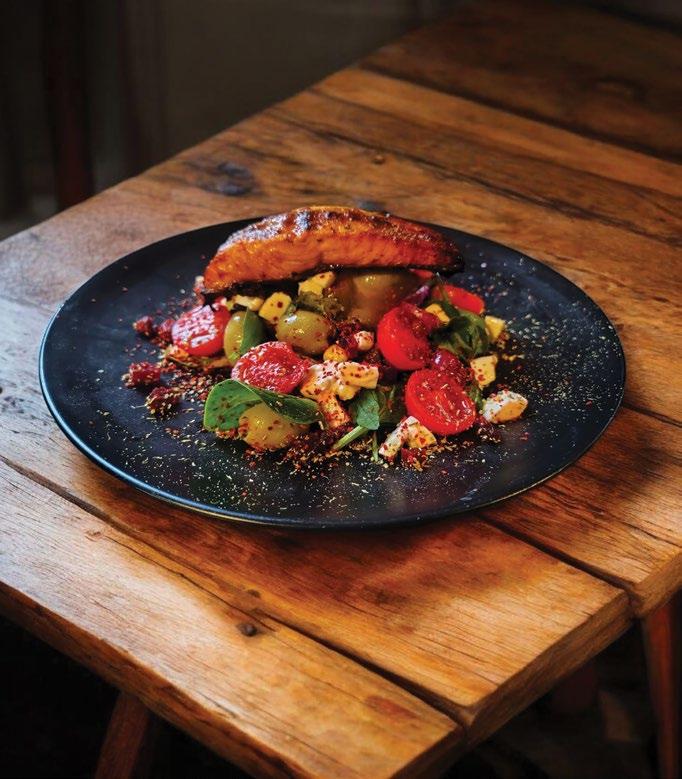

Ingredients
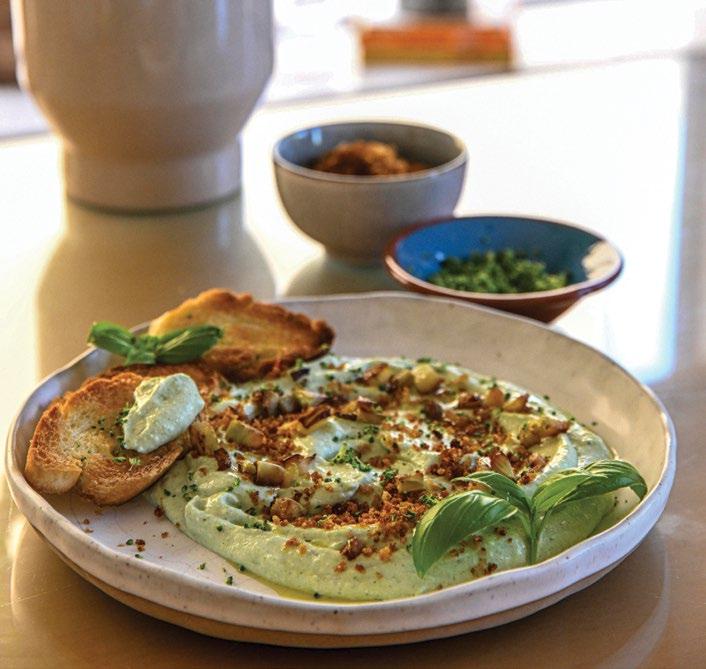
1 medium broccoli (florets & stem)
1 tub Benna Irkotta Friska
1 Ġbejna Moxxa
2 cloves garlic, halved
3 tbsp olive oil
3 slices stale bread
4 anchovy fillets
2 tbsp fresh parsley, finely chopped
½ mild chilli, deseeded and chopped
Method
Cut the broccoli into florets and stems. Slice off the tiny buds from the florets and set them aside for garnish. Peel the tough outer layer of the broccoli stem, then dice the stem into small cubes. Boil the florets until tender about 5 minutes, drain well and let them cool slightly.
Sauté the broccoli stem cubes in a pan over medium heat with 1 tbsp olive oil and 1 garlic, until golden for about 5 minutes. Set aside.
Tear the bread into small chunks and then use a food processor to reduce to coarse breadcrumbs. In the same pan, heat 2 tbsp olive oil over medium heat. Add anchovies, 1 tablespoon olive oil, chilli and the remaining garlic, stirring until fragrant. Add the bread crumbs and toast until golden and crisp for around 5-7 minutes. Stir in parsley and the remove from heat. Blend the boiled florets with ricotta, chopped ġbejna, salt and black pepper until smooth. Taste the dip and adjust with desired amount of salt and pepper.
Transfer the dip to a serving dish and top with the sautéed broccoli stems and scatter the reserved raw broccoli buds for crunch. Sprinkle generously with crispy pangrattato and drizzle with a little extra olive oil. Serve with toasted bread.
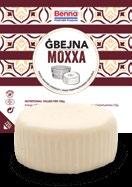
4
"THESE INGREDIENTS COME TOGETHER TO CREATE A DISH THAT’S AS NOURISHING AS IT IS DELICIOUS."
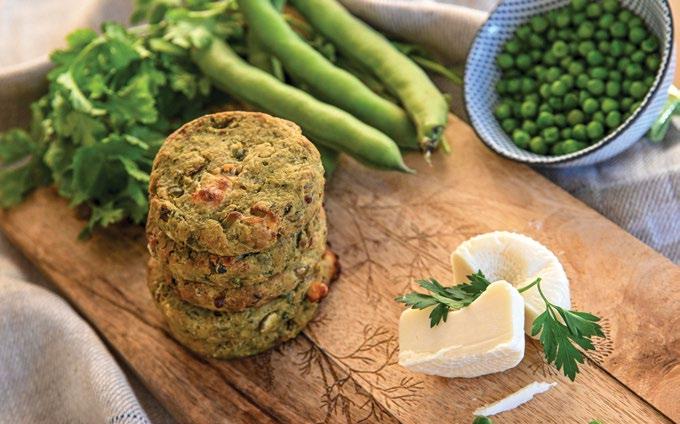
Ingredients
200g frozen shelled broad beans
200g frozen peas
Juice of 1 lime
100g plain flour
100g breadcrumbs
3 spring onions, finely chopped
1 Benna Ġbejna
½ a bunch of fresh coriander
2 garlic cloves, crushed
1 large egg
2 tbsp olive oil
Method
Preheat oven to 180°C.
Place the defrosted vegetables, flour and breadcrumbs in a food processor. Add garlic, spring onions and tear in the coriander leaves. Crack in the egg and season well with salt and black pepper. Add oil and blitz to a rough paste.
Chop the ġbejna in small cubes and amalgamate with the bean mixture. Using flour dusted hands, shape mixture into thick patties and place on a tray lined with baking paper.
Brush each pattie with olive oil and bake for 30 minutes until golden brown. Serve with a salad on the side and lime wedges.
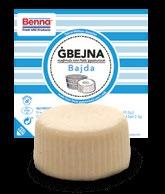


WE REVISIT KIERAN CREEVEY AS HE CAPTURES THE ESSENCE OF THE OCEAN WITH 3 CREATIVE FORAGED DISHES
There’s something deeply satisfying about stepping outside and letting the land tell you what’s for dinner. Foraging isn’t just a return to nature — it’s a return to instinct. With no shopping list or meal plan, you're guided instead by the seasons, the terrain, and a bit of curiosity.
Ingredients
For Scallops
2 king scallops, roe removed, washed and cleaned
2 scallop shells halved and cleaned
Whether it’s wild garlic in spring, blackberries in late summer, or oyster mushrooms after a rain, foraging opens a portal to flavors that rarely make it to supermarket shelves. It forces you to look closer, slow down, and develop a deeper relationship with your surroundings — and your food.
2 tbsp sea buckthorn juice (foraged in the autumn, frozen and blitzed in a blender or available from health food stores)
2 thick slices of chorizo, diced
For the orange and seaweed butter
Rind of 1 orange, blanched 3 times in boiling water and finely sliced 100g butter, softened.
1-2 tsp dried, ground kelp, or foraged, dried and sliced finely
For the flavoured butter (Make this 1 day in advance.)
1. Soften the butter overnight or near a fire.
2. Mix in the orange peel and dried kelp.
3. Roll the butter into a cylinder in a sheet of tinfoil or greaseproof paper and place in the fridge.
Cooking with foraged ingredients means thinking on your feet. A handful of wild sorrel might become a bright pesto. Nettles? Steam them like spinach, stir into risotto. It’s in these improvised moments that real kitchen creativity kicks in. You’re no longer just following steps — you’re responding, riffing, tasting, trusting.
Method for Scallops
(This requires marinating time so start 1 day ahead or in the morning.)
Season the scallops lightly with sea salt, place in a small tupperware box and pour over sea buckthorn juice.Refrigerate if marinating overnight
For the flavoured butter
Place two shell halves directly on the coals. Add a slice of the flavored butter and wait for it to sizzle before adding the scallops. Cook the scallops for 2 minutes on each side, then add the chorizo cubes. Check that the scallops are cooked through—they should be white all the way to the center but still tender, not rubbery. Top with another thin slice of butter and serve straight from the shell with forks.
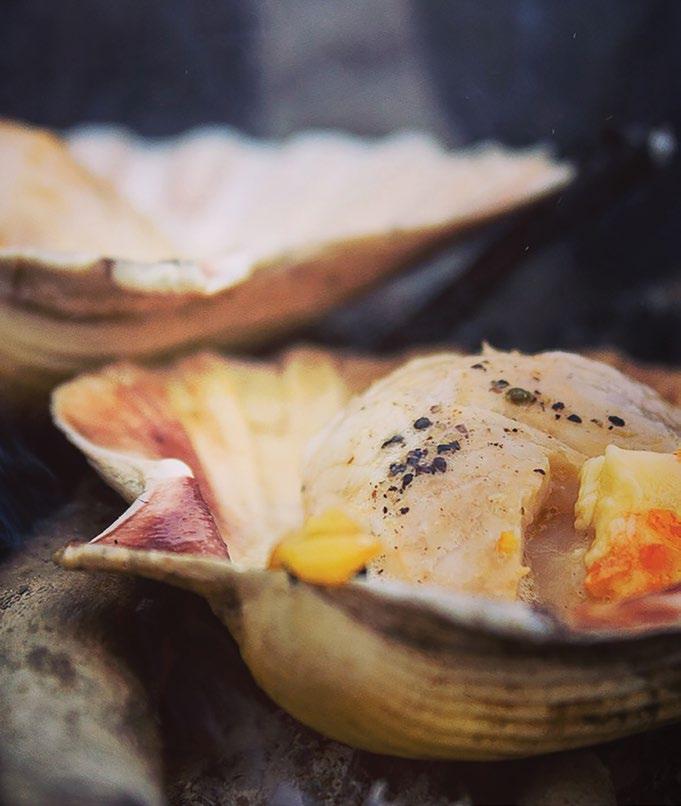
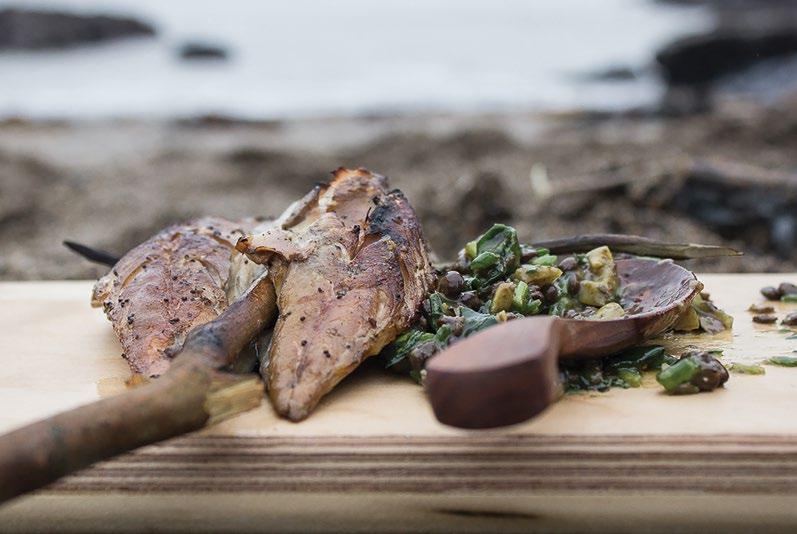
Ingredients: Serves 2
To cook the mackerel fillets on a stake/spit you'll need:
6 x 2-3 foot long wooden sticks - little finger thickness (soak in sea water briefly prior to cooking)
12 x 12 inch long wooden sticks, pencil thickness (as above), sharpened to a point on one end
3 foot thin wire or thick twine (soaked in water) cut into 6 pieces to secure.
Method:
Place each mackerel fillet between 2 long sticks - running from tail to head, one on the skin side, one on the flesh side.
Secure tightly at both ends with the wire/twine. The fish should be held tight between the 2 stakes.
Place the mackerel skin side down somewhere clean and make 2-3 small incisions (lining up) on each side, close to the edge through the flesh and skin.
To keep the fillet open, starting from the head end, run the small sticks - point first from the flesh to the skin, through the incision, behind the back
of the long stake, and through the opposite incision in the skin to the flesh (flesh-skin, skinflesh)
Stake the mackerel vertically or at a slight angle in front of the fire, about 1- 2 feet away, making sure that the flames are not going to touch the fish.
The distance from the fire can be altered, depending on its size and heat.
Check the fish periodically. Due to the cooking method, exact times are not possible, but thanks to the same method it's very easy to see when the flesh is cooked.
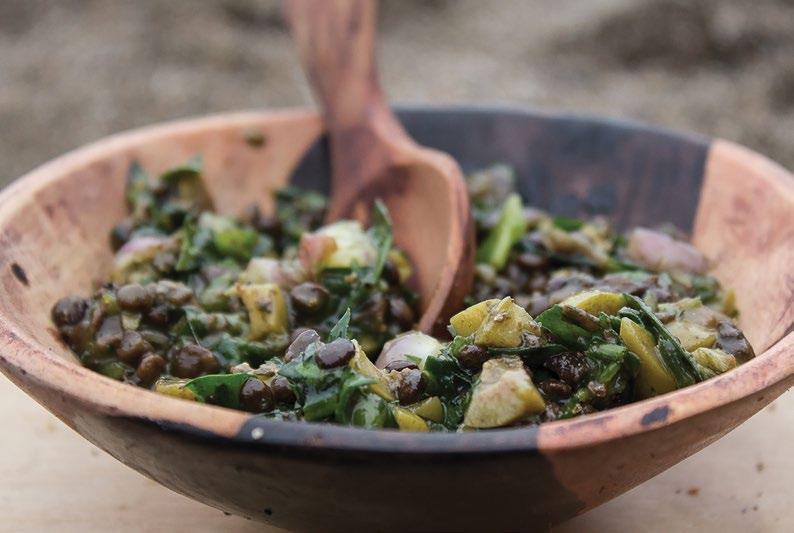
For Tapenade
Roughly chop the olives, sea purslane and nettle tops into a bowl, add the oil, anchovy, garlic, lentils, and lemon juice. Mix well.
To serve
Place the mackerel fillets skin side down on a clean stone, wooden board or plate, serve with the tapenade. Eat with your hands and spoons.
There’s something primal and poetic about cooking fish over an open flame. This method — a nod to ancient coastal traditions — uses simple tools: wooden stakes, twine, and the heat of a well-tended fire. Whole mackerel fillets are pinned open, suspended near the embers, and slowly roasted to smoky, sea-scented perfection. The result? Crisped skin, tender flesh, and a depth of flavour no pan can deliver. Best enjoyed outdoors, barefoot, and with good company. >>
Foraging is rewarding in many ways — but when in doubt, leave it out. Never eat anything you can’t positively identify.
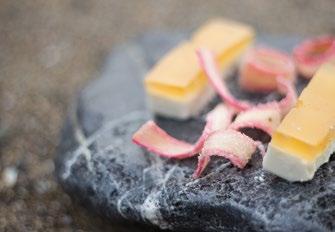
Ingredients
For the apple panna cotta
75g caster sugar
200ml double cream
2g agar agar powder
200ml coconut milk
100g apple puree
For the Apple & elderflower gel
225g fresh pressed apple juice
25g elderflower cordial
2g agar powder
For the candied rhubarb strips
2 sticks forced rhubarb
4 tbsp caster sugar
4 tbsp apple juice
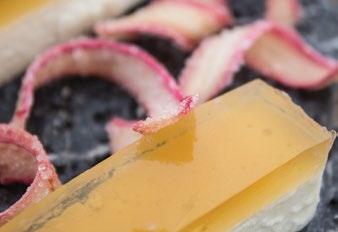
Method
Preheat the oven to 90°C (194°F).
In a small saucepan, heat apple juice and stir in caster sugar until fully dissolved.
Slice rhubarb into 6-inch chunks, then cut lengthwise into thin ribbons. Dip each ribbon into the syrup, then lay flat on a parchment-lined baking sheet.
Dry in the oven for 45 minutes to 1 hour, or until just crisp but pliable. Once cool, store in an airtight container (Ziploc bag or Tupperware).
Panna Cotta (Prepare 2 days ahead or the morning of; can also be made on-site)
Note: Agar powder sets at room temperature, so refrigeration is not necessary.
In a saucepan, combine cream, coconut milk, and apple purée. Heat gently over medium. Once warm, add caster sugar and agar powder, whisking vigorously.
Bring the mixture to a boil, then pour into a shallow container (e.g., Tupperware). Let it set.
Elderflower Jelly Topping
Clean the saucepan and pour in apple juice and elderflower cordial. Heat over medium, then whisk in agar powder. Bring to a boil. Gently pour the mixture over the set panna cotta using the back of a spoon to avoid disturbing the surface. Allow to cool and set fully at room temperature. Seal the container and store until ready to serve or transport.

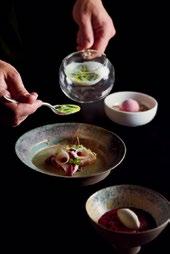




















here’s something deeply satisfying, almost meditative, about making puff pastry from scratch. It’s just flour, water, butter, and salt, but with time, patience, and a few good folds, those humble ingredients turn into golden, flaky
the process. You roll, you fold, you chill, again and again, and every step builds delicate layers that rise and crisp beautifully in the oven. There’s no yeast, no baking powder. Just steam and skill doing the heavy lifting.
watching hard work bloom.
What’s most rewarding is its versatility. Wrap it around ripe fruit for a quick tart. Tuck in cheese and herbs for a savory twist. Or simply bake it as is and watch people marvel at the crunch.

½ tsp salt
¾ cup unsalted butter, (very cold + cubed)
6–8 tbsp ice-cold water
"IT’S NOT JUST ABOUT TECHNIQUE — IT’S ABOUT RHYTHM, PATIENCE, & ENJOYING THE PROCESS."
the flour until it resembles breadcrumbs. Add the cold water gradually, mixing with a knife until the dough just comes together. Form into a rough square, wrap in cling film, and chill for 30 minutes.
For the butter
Place the remaining 200g of chilled butter between two sheets of baking paper. Bash and roll it into a flat square about 1cm thick (roughly 13x13cm). Chill if it gets too soft.
Enclose the butter
On a lightly floured surface, roll the dough into a square roughly 26x26cm. Place the butter block in the center like a diamond (diagonally). Fold the corners of the dough over the butter to completely enclose it. Seal the edges.
Start the folding
Roll the dough into a long rectangle (about 20x60cm). Fold the top third down, then the bottom third up over it, like a letter. This is your first "turn". Rotate the dough 90°, then repeat the rolling and folding for the second turn. Wrap and chill for 30 minutes.
Repeat turns
Repeat the rolling, folding, rotating, and chilling process 4 more times (6 turns total), chilling for 30 minutes between each 2 turns.
After the final chill, your puff pastry is ready to roll out and use for sweet or savoury dishes.

"THE SECRET TO A PERFECTLY GOLDEN SPINACH PIE IS TO LET YOUR FILLING COOL COMPLETELY BEFORE WRAPPING IT IN PASTRY"
Ingredients
500g puff pastry
(store-bought or homemade)
400g fresh spinach
(or 250g frozen, thawed and well-drained)
150g feta cheese, crumbled
1 small onion, finely chopped
1 garlic clove, minced
1 can tuna
3 tbsp grated Parmesan
(optional, for extra flavour)
2 tbsp olive oil
2 tbsp Vera kunserva
Salt and black pepper, to taste
1 egg (beaten, for brushing)
Method
Preheat the oven to 200°C (400°F) and line a baking dish (roughly 20x30cm) with parchment paper or lightly grease it.
In a pan over medium heat, add olive oil and sauté the chopped onion until soft. Add garlic and cook for another minute. Stir in the spinach and cook until wilted (if using fresh). Drain any excess liquid thoroughly. Let cool slightly.
In a bowl, combine the cooked spinach mixture, crumbled feta, 2 eggs, Parmesan (if using), salt, and pepper. Mix well.
Roll out half the puff pastry and line the bottom of the dish, allowing a little overhang. Spoon in the spinach filling and spread evenly. Roll out the remaining pastry and place it on top. Press the edges to seal and crimp with a fork. Cut a few small slits on top to allow steam to escape.
Before baking brush the top with the beaten egg. and bake for 30–35 minutes or until golden brown and puffed. Let it rest for 5–10 minutes before slicing and enjoy!
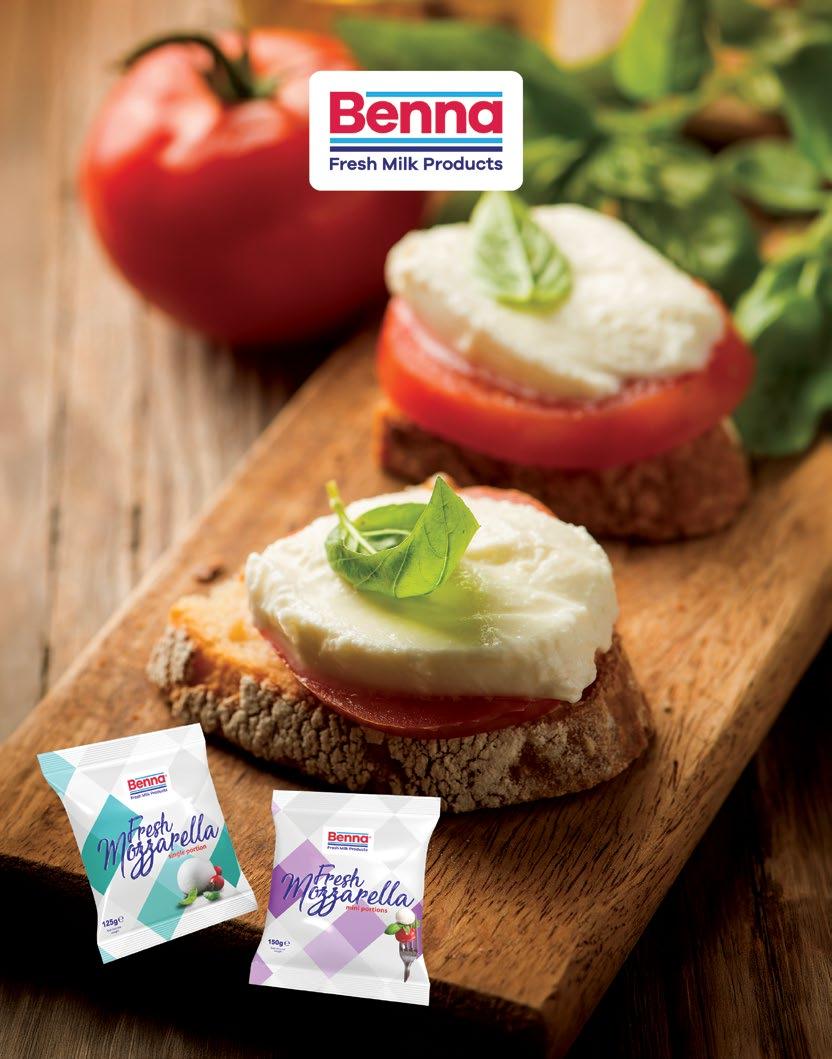

1 large Maltese ftira
2 Tbsp Vera Kunserva
Good quality extra virgin olive oil
1 tbsp capers
1 tbsp black olives (pitted)
A few fresh mint leaves
1 small onion (thinly sliced)
1 can tuna (175g), drained and flaked
2 sundried peppers (or dried sweet local peppers)
1 authenic Gozitan gbejna, crumbled or sliced
Bigilla (spread over the kunserva)
Salt and freshly ground black pepper, to taste
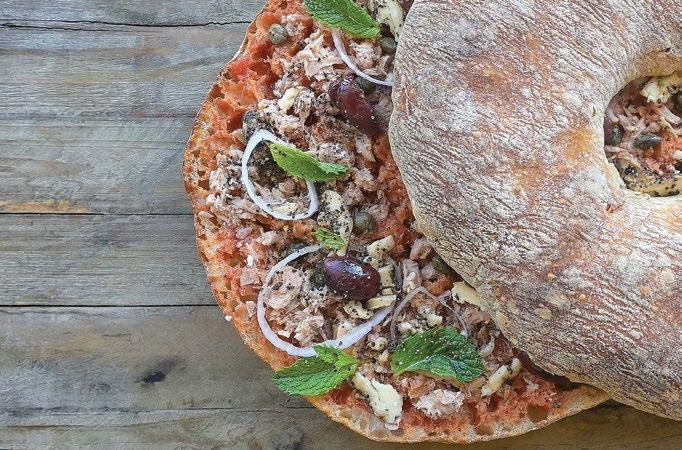
he story of the Ftira begins in the 16th century, during the time of the Knights of St John, when public wood-fired ovens were introduced across Malta, especially in Valletta. Bakers would flatten small discs of dough to test the heat of their roaring ovens before baking larger batches of loaves. These “test breads,” often scorched and rustic, gained popularity as a quick, satisfying snack and evolved into what we now know as Ftira. Early records refer to it as xawwata or schiacciata, referencing its flattened shape and charred finish.
This traditional Maltese icon is shaped by hand and baked directly on the stone floor of a wood-fired oven, which gives it its unmistakable smoky aroma and blistered crust.
At the heart of every great Ftira biz zejt is the bread itself. No matter the toppings, the ftira is the star of the show. A proper ftira should be charred, very crusty, and blistered, with a soft interior full of air pockets. It’s thick, rustic, and proudly imperfect. That oven-fresh warmth and crunch are nonnegotiable. As they say, “Il-ftira sħuna tajba.”
Commonly filled with local favourites like tomato or kunserva, tuna, olives, capers, mint, and gbejniet, ftira is a canvas for Maltese flavour. But its soul
lies in its texture, bake, and history. It’s an edible echo of the past, kept alive in the heart of every Maltese family for centuries.
Ħobż biż-Żejt is more than just a meal. It is a cultural symbol and a link to Malta’s rural roots. Once a practical solution for farmers and labourers needing a quick, hearty lunch in the fields, it became a staple in the Maltese diet due to its simplicity, affordability, and nourishing quality. Even today, it is a favourite snack or light meal, especially in summer when the tomatoes are at their sweetest and the craving for something fresh and satisfying sets in.
From humble beginnings as a baker’s heat test to a UNESCO-listed icon, ftira remains Malta’s most beloved bread. It is a symbol of heritage, simplicity, and home.
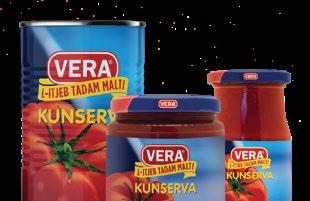
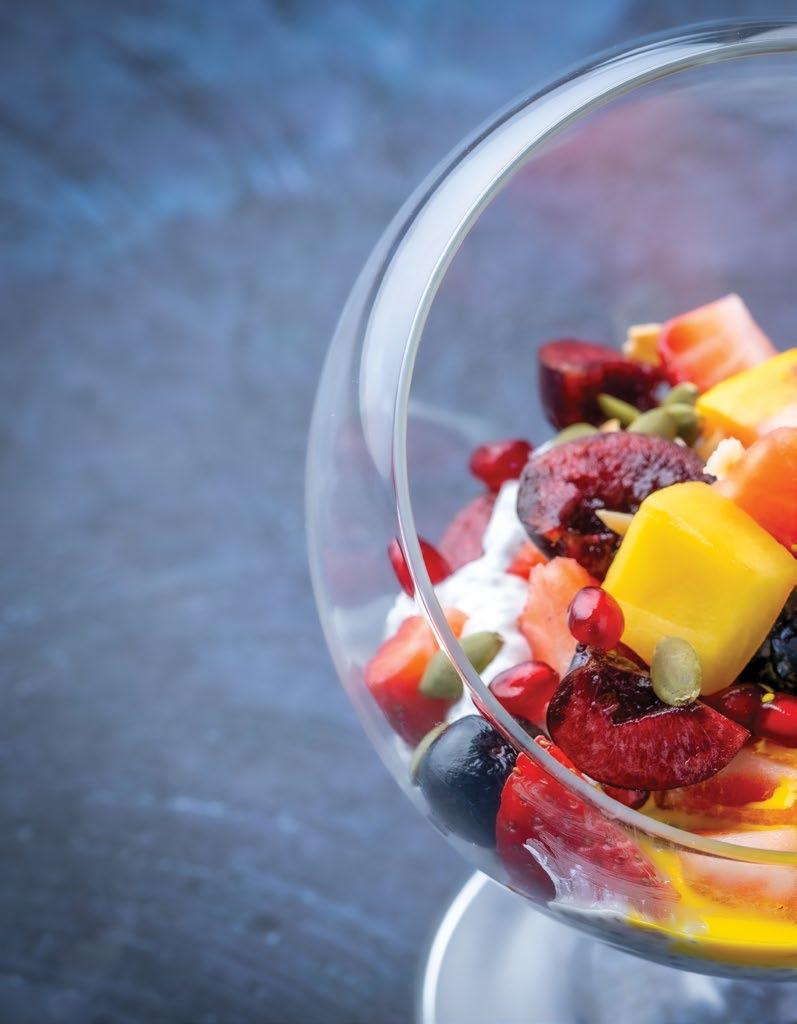
Ingredients: Serves 2
For the Saffron Cream
20ml cooking cream
Pinch saffron powder
For the Chia Cream Mix
60ml soya almond milk
1 tsp coconut sugar
1/2 tsp chia seeds
1/8 tsp cardamom powder
For the Chia Berries
2 large strawberries
4 raspberries
8 blueberries
4 fresh cherries
Few pomegranate seeds
1 tbsp mango
1 tsp almond slices
1/2 tsp pumpkin seed
1/2 tsp saffron cream
100ml chia cream mix
Method
For the Saffron Cream:
Mix the cooking cream with the saffron powder in a bowl.
For the Chia Cream Mix:
Add the soya almond milk, coconut sugar, chia seeds, and cardamom powder to a bowl. Mix and let sit for 15 minutes at room temperature.
For Assembling the Parfait:
Layer the prepared chia cream mix, the berries and mango, and saffron cream in a glass. Garnish with pumpkin seeds and almond slices, then refrigerate.
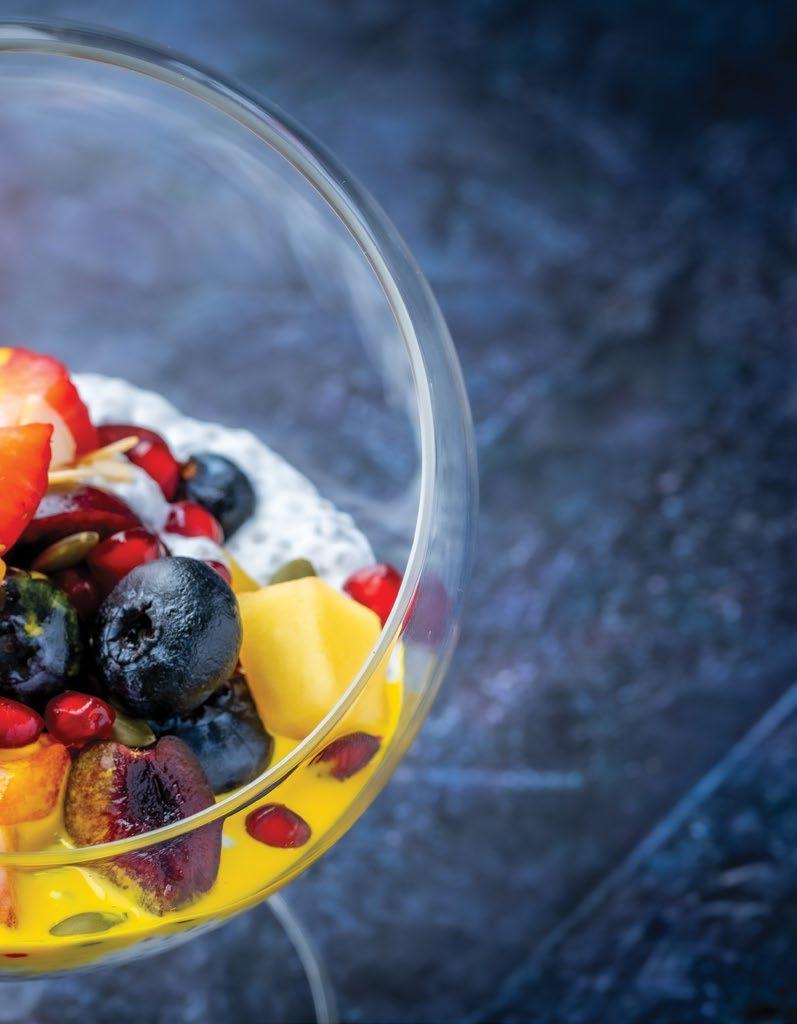
“Let the chia seeds soak long enough to fully absorb the milk — this creates a creamy texture that’s both satisfying and nourishing.”
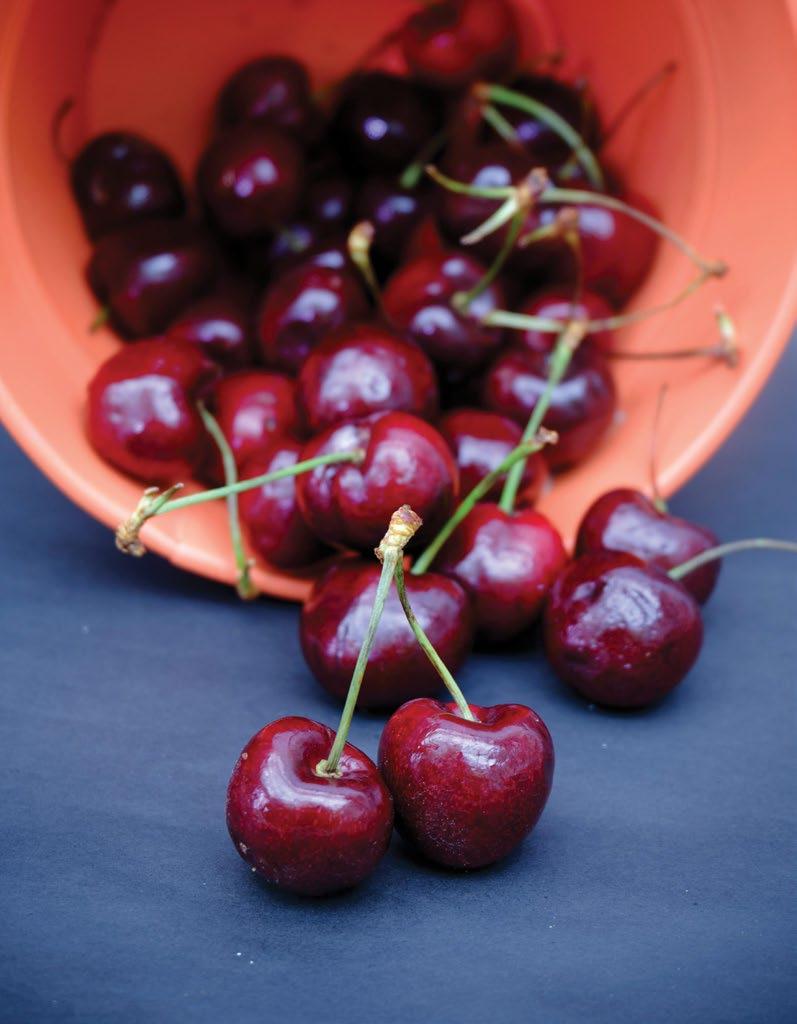
Layered Strawberry Cream Chia – Prep/Chill time: 40min, Serves: 1
Ingredients
For the Chia Cream Mix
6 tbsp almond milk
2 tbsp coconut sugar
2 tbsp chia seeds
1/4 tsp cardamom powder
For the Strawberry Cream
6 tbsp whipping cream
3 tbsp strawberry puree
1 tbsp white sugar
Ingredients to Assemble
1/2 pc brownie crumbled
10 tbsp chia cream mix
8 tbsp strawberry cream
2 chopped strawberries
Sprinkle of almond slices
Mint leaves to garnish
Method
Chia Cream Mix
Mix the almond milk, coconut sugar, chia seeds, and cardamom powder, let it chill for 20 minutes.
Strawberry Cream
Whip the cream with the puree and the sugar.
Assembly
In a clear square serving dish, layer 1/2 the brownie, chia mix, strawberry cream, & top with the strawberries, 5g almonds, mint.
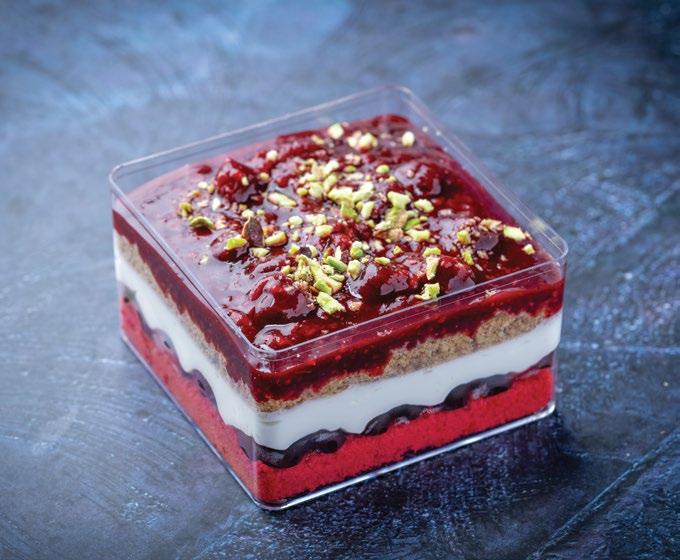
Few desserts inspire such instant craving as the classic Black Forest cake (Schwarzwälder Kirschtorte), a luscious combination of chocolate, cherries, and whipped cream that has captivated dessert lovers around the world.
This iconic German confection hails from the Black Forest region (Schwarzwald) of southwestern Germany, a land known for its dense forests, rich culinary traditions, and— fittingly—its sour cherries and famed cherry brandy, Kirschwasser. The cake’s origins are somewhat debated, but most historians trace
For the chocolate sponge (Biskuitboden)
6 large eggs
150 g (¾ cup) granulated sugar
1 tsp vanilla sugar or extract
100 g (¾ cup) all-purpose flour
50 g (½ cup) unsweetened cocoa powder
50 g (about ½ cup) cornstarch
1 tsp baking powder
Pinch of salt
For the filling
500g sour cherries (fresh pitted or jarred)
300ml cherry juice (reserved from jar or use pure cherry juice)
2 tbsp cornstarch
50–75ml cherry brandy (Kirschwasser)
600ml heavy cream
2 tbsp powdered sugar
1 tbsp vanilla sugar or 1 tsp vanilla extract
it back to the early 20th century, when pastry chefs in the region began layering chocolate sponge with whipped cream, cherries, and a generous splash of Kirsch.
Traditionally, the cake features layers of light chocolate sponge, soaked with Kirsch, and interspersed with whipped cream and sour cherries. The exterior is lavishly coated with more cream, dark chocolate shavings, and crowned with whole cherries. The balance of rich chocolate, tart fruit, and boozy warmth is what makes Black Forest cake truly special.
For decoration
Dark chocolate shavings
Whole cherries (fresh or maraschino), to garnish
Method
For the sponge
Preheat oven to 180°C (350°F). Grease and line a 24 cm (9½ inch) springform pan.
Beat eggs with granulated sugar and vanilla sugar until very light and fluffy (about 8–10 mins).
Sift flour, cocoa, cornstarch, baking powder, and salt. Gently fold into egg mixture. Pour into the pan and bake 25–30 mins. Let cool completely. Slice into 3 equal layers.
For the cherry filling
In a saucepan, heat reserved cherry juice. Mix cornstarch with a little cold juice, then whisk
While countless modern variations exist, true enthusiasts argue that authentic Kirschwasser is non-negotiable—it imparts a subtle complexity that ties the dessert to its regional roots.
Whether enjoyed at a sunlit café in BadenWürttemberg or recreated in your own kitchen, the original Black Forest cake remains a testament to the indulgent side of German baking—and a slice of culinary history worth savoring.
into the hot juice. Simmer until thickened. Add cherries and 2 tbsp Kirsch. Cool completely.
For the cream
Beat cream with powdered sugar and vanilla sugar until stiff peaks form.
For the cake
Place the first sponge layer on a cake stand. Brush generously with Kirsch. Spread with half the cherry filling and a layer of whipped cream. Repeat with second layer.
Top with final layer, brush with Kirsch, and cover entire cake with whipped cream.
To Decorate
Press chocolate shavings around the sides and top. Pipe rosettes of whipped cream around the edge and top each with a cherry.

Prep/Cook time: 90min, Chill time: 120min Serves: 6–8+

I was seven the first time I helped Nanna bake her legendary almond biscuits—not the hard, sugar-dusted kind in cafés, but the real ones: tender, buttery, warm from the oven, crumbling at the edges, melting on the tongue.
We were in her sunlit kitchen in Montalcino, Tuscany. Outside, the hills rolled on, dotted with olive groves, lavender, and the hum of bees. A 150-year-old fig tree stood beyond the garden wall. Inside, the scent of toasted almonds and sugar wrapped around us like memory.
Nanna didn’t use measuring cups—just scoops and pinches. She baked by feel. I stood on a stool beside her, clumsy and curious. “Slow, love,” she’d whisper. “Biscuits need love and patience.”
We shaped the dough into messy mounds and pressed almonds just off-center. While they baked, we drank tea—mine mostly milk, hers strong and tannic. When the oven opened, heat sighed into the room. I always touched one too soon. I always burned my fingers.
We ate the first biscuit at the counter, no napkins—just grins and crumbs. “These are for company,” she said, “but only the kind who know where the kettle is.”
She never wrote the recipe down. Said it changed with the weather, your mood, the sound of rain.
Years passed. I moved, got busy, bought biscuits. But when life feels too fast, I pull out her chipped blue bowl and make them. I still don’t know her exact “scoop,” but I try. I still burn my fingers on the first one.
I’ve shared the biscuits, but never the recipe—until now.
Because love, like these biscuits, lasts quietly.
And maybe that’s what makes them legendary.
Classic Almond Buscuits – By Served Kitchen – Prep/cook: 35min – Makes: 20

“These delicate almond biscuits carry more than flavour — they hold stories, tradition, and the warmth of moments shared."
Ingredients:
360g ground almonds
½ cup flour
½ cup sugar
1 packet margarine
1 tsp vanilla
Icing sugar, for topping
Method:
These delicate, nutty almond biscuits are perfect for pairing with coffee or tea. To make them, combine the ground almonds, flour, sugar, margarine, and vanilla in a bowl. Mix until a soft dough forms, then chill in the refrigerator for one hour. Once chilled, roll out the dough and shape it into strips. Place them on a greased baking tray and bake for 20–25 minutes, or until lightly golden. While still warm, generously dust with icing sugar for a sweet, snowy finish.




